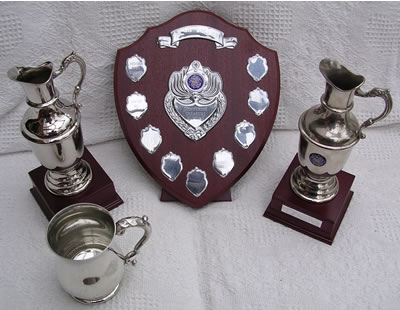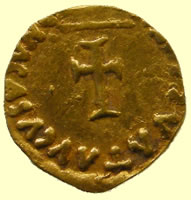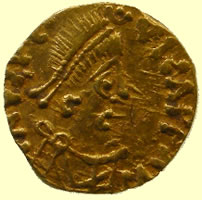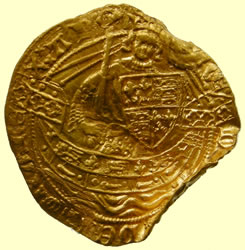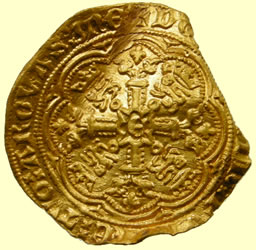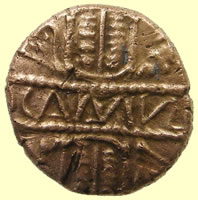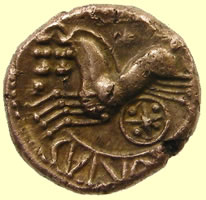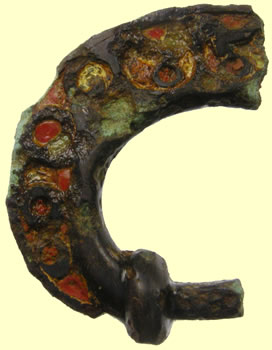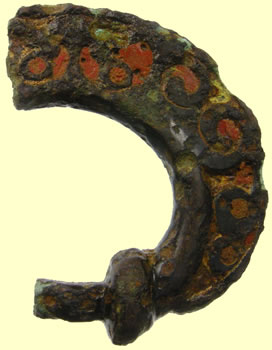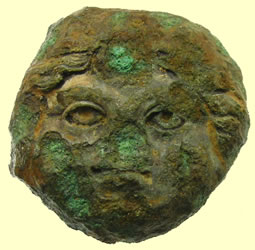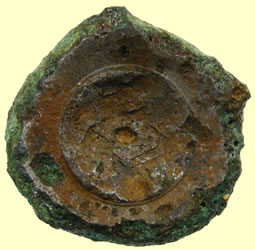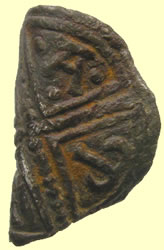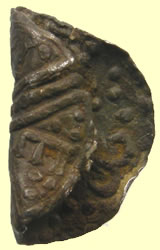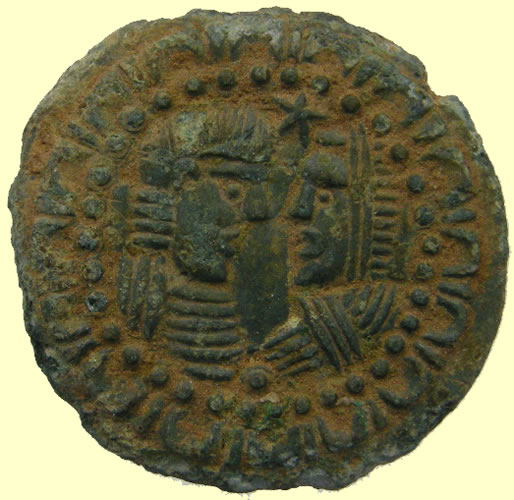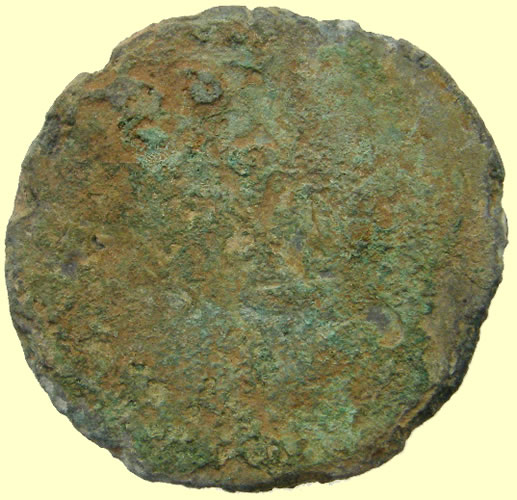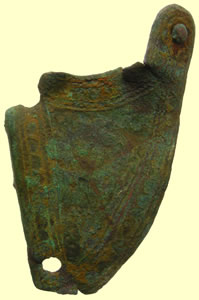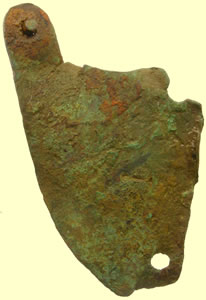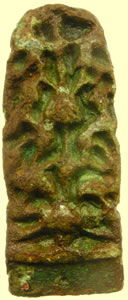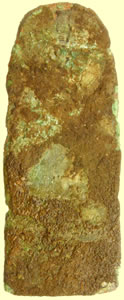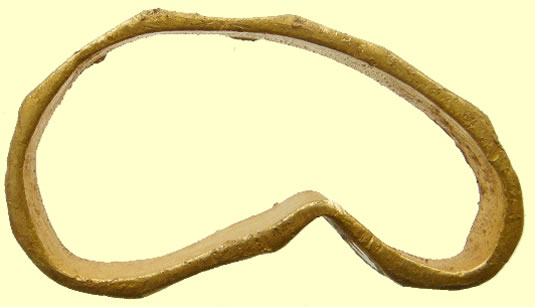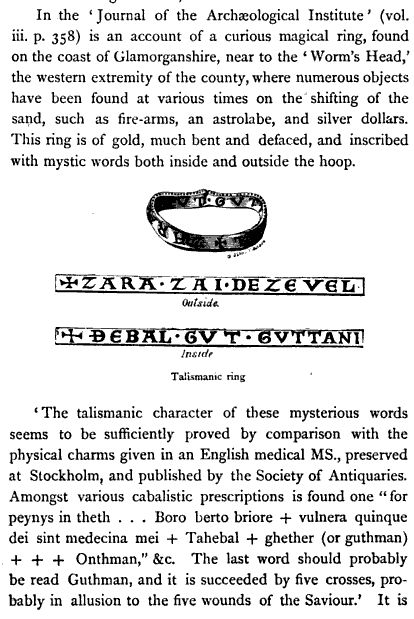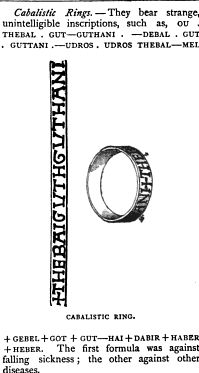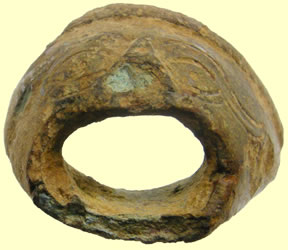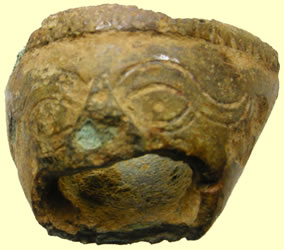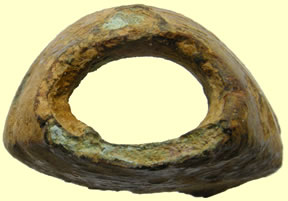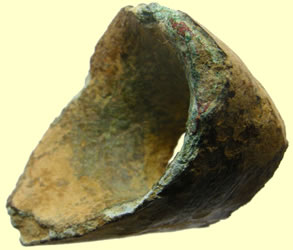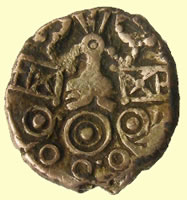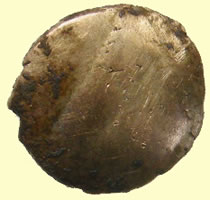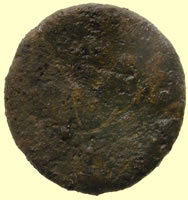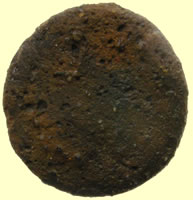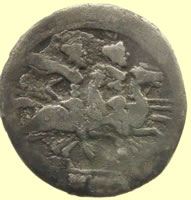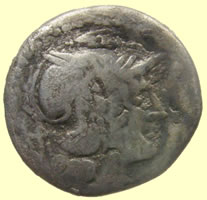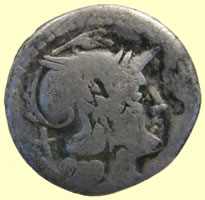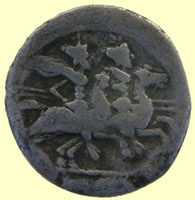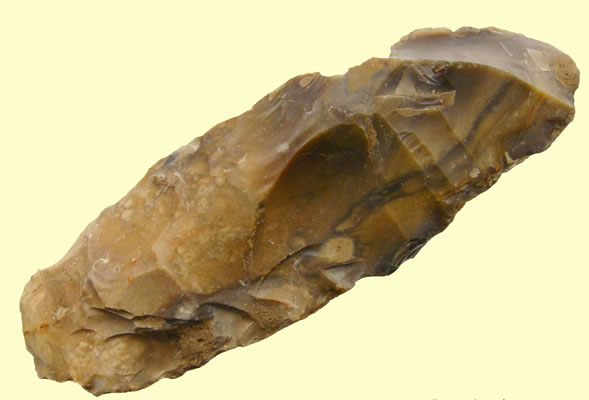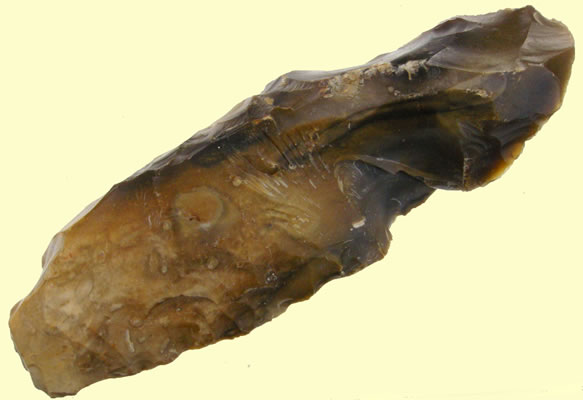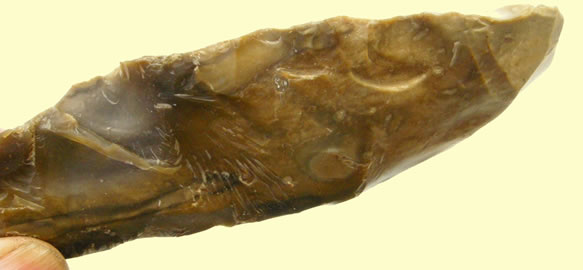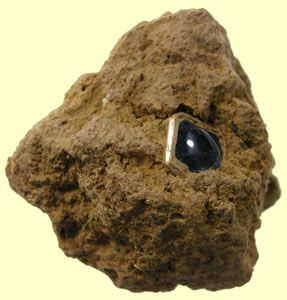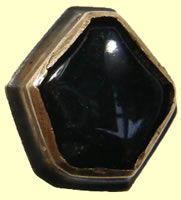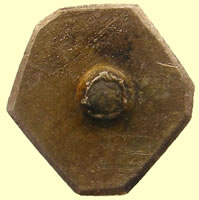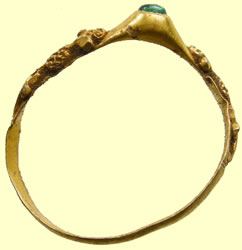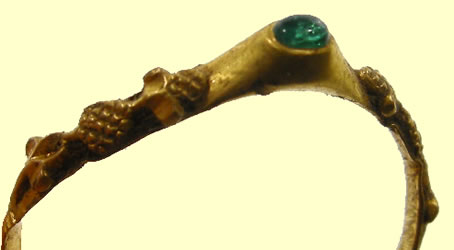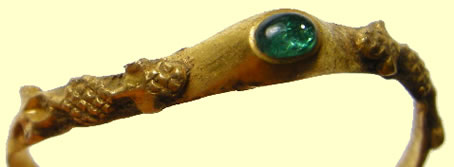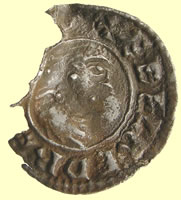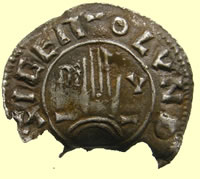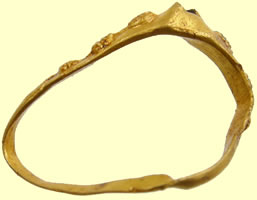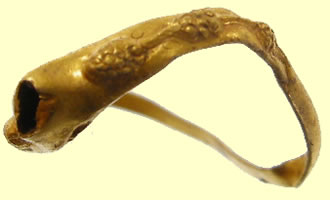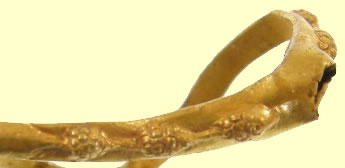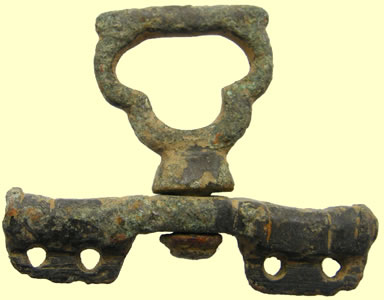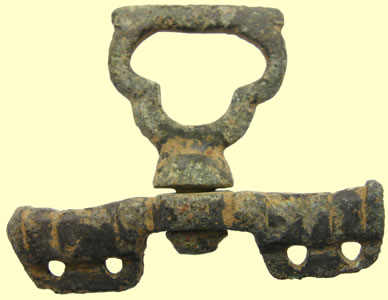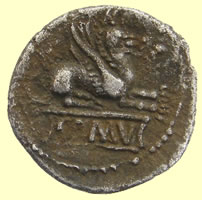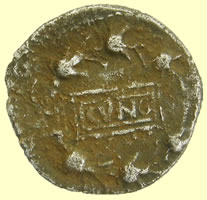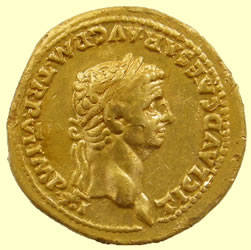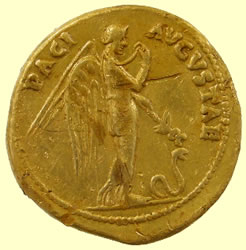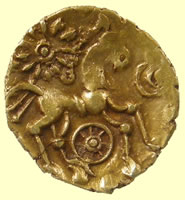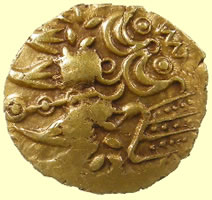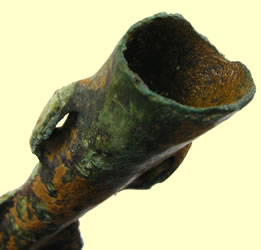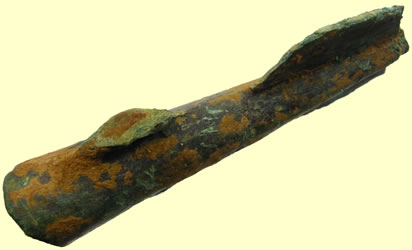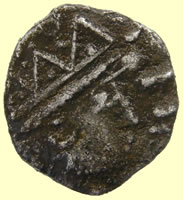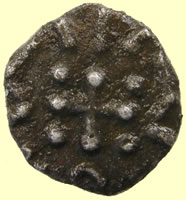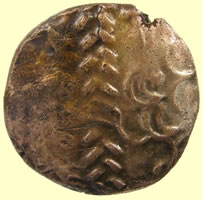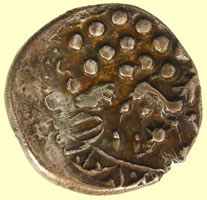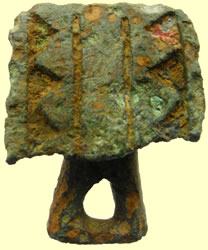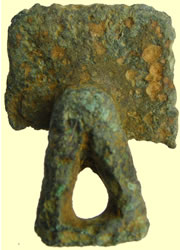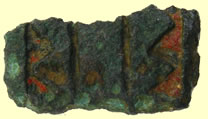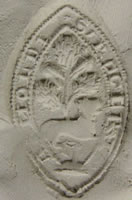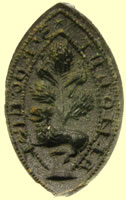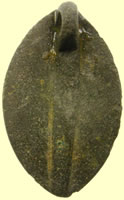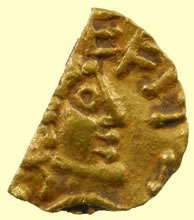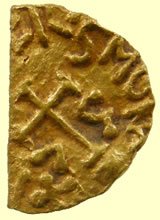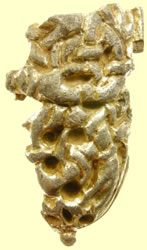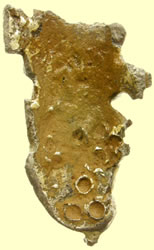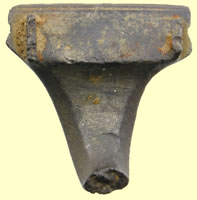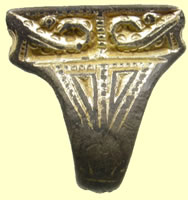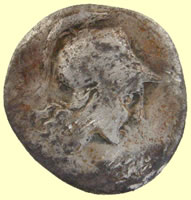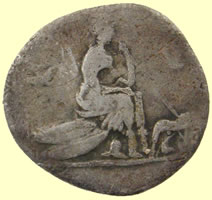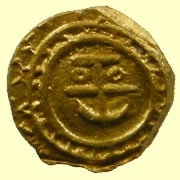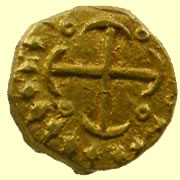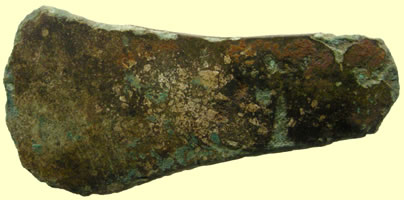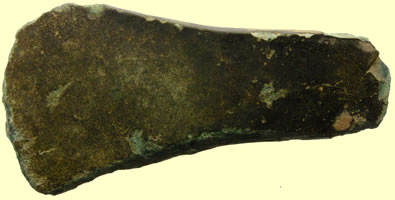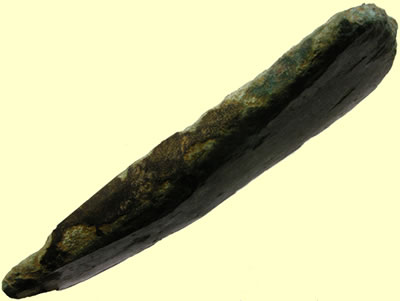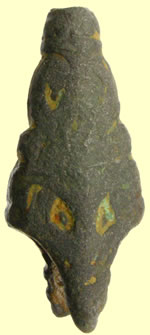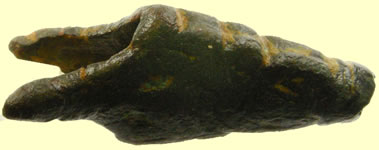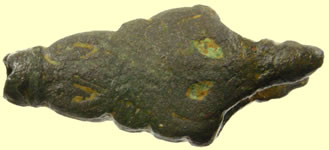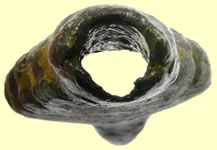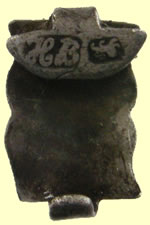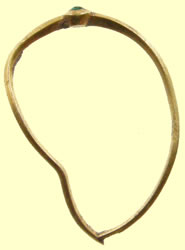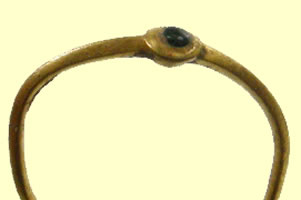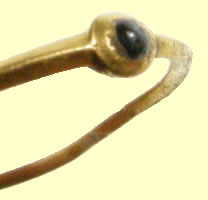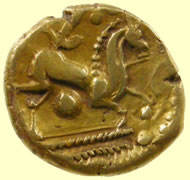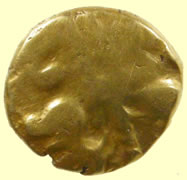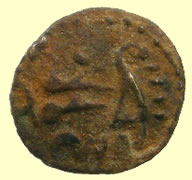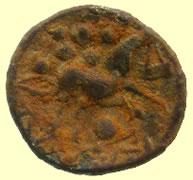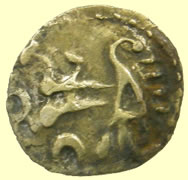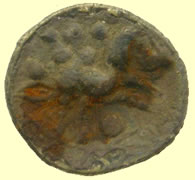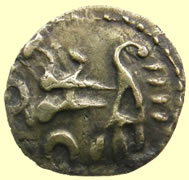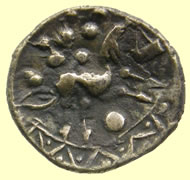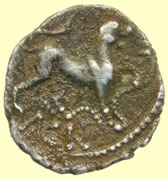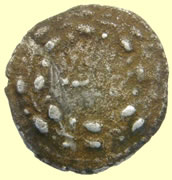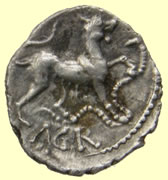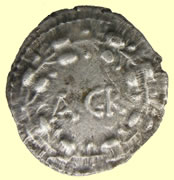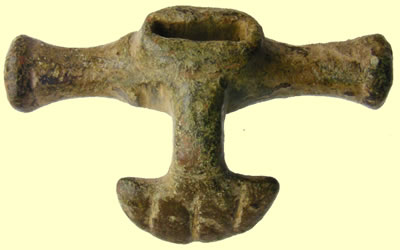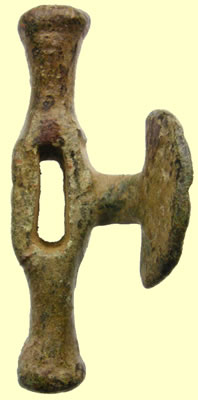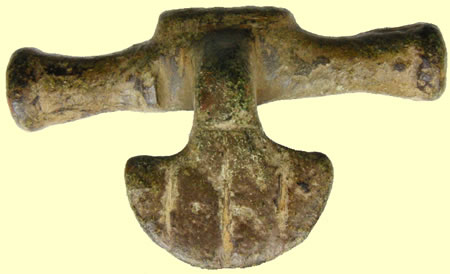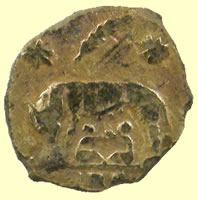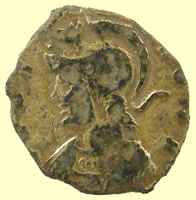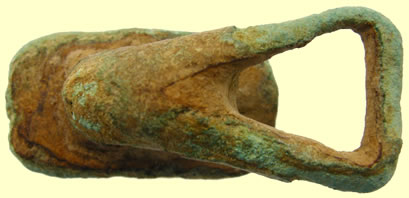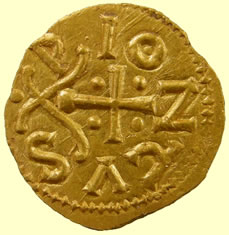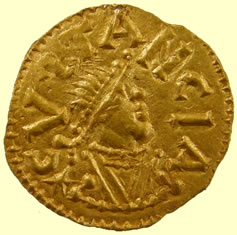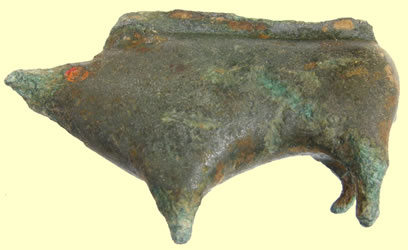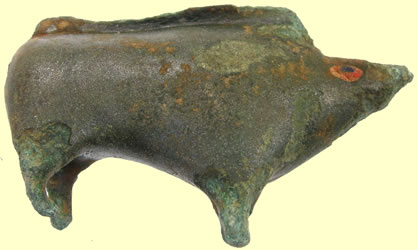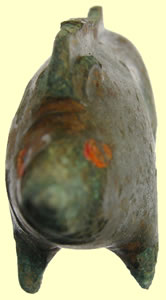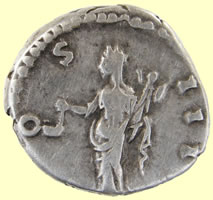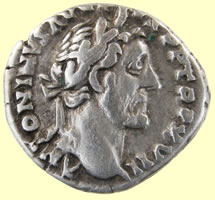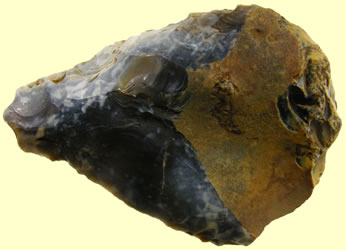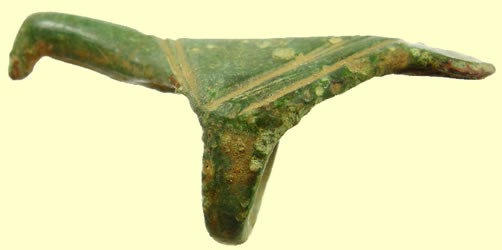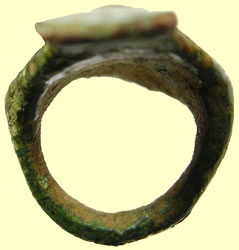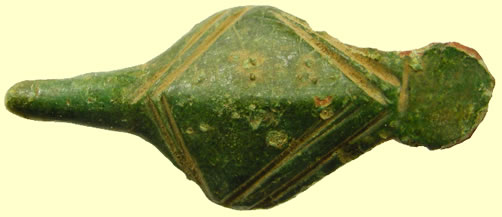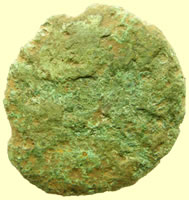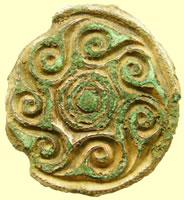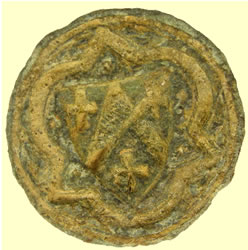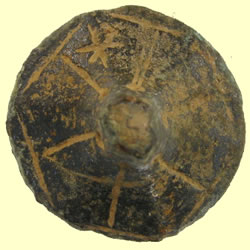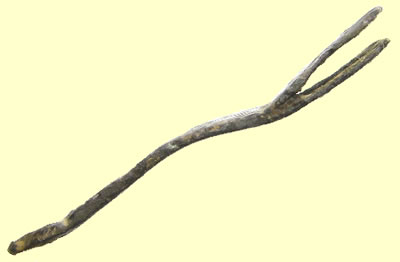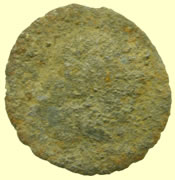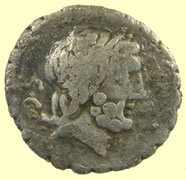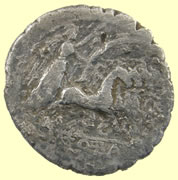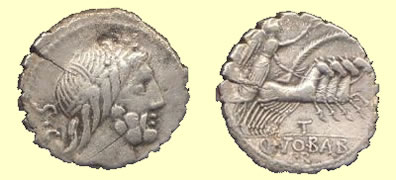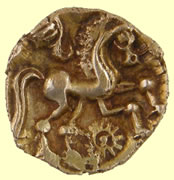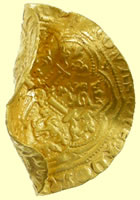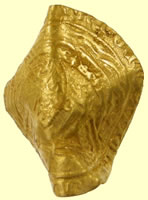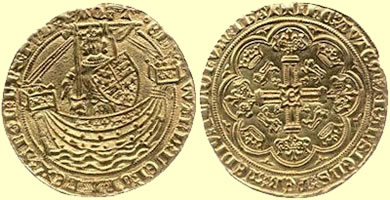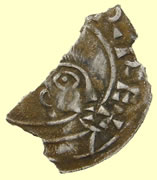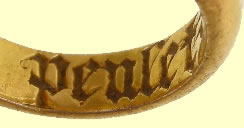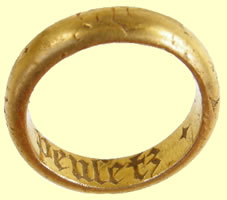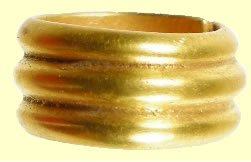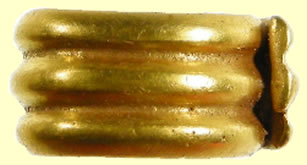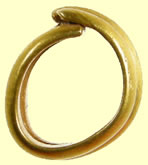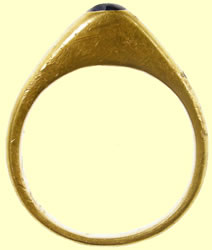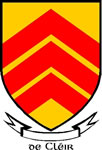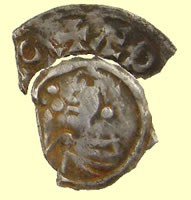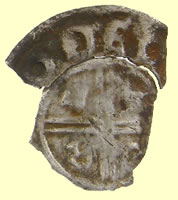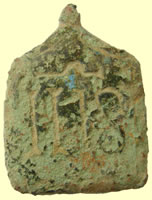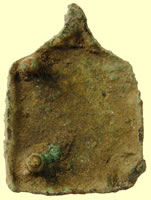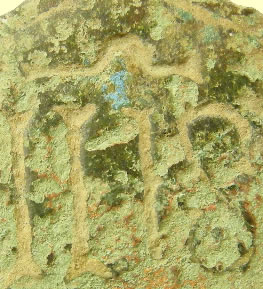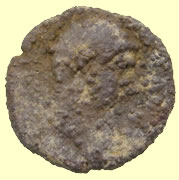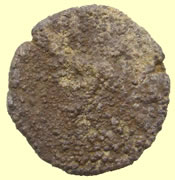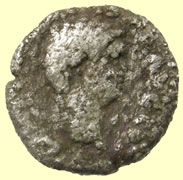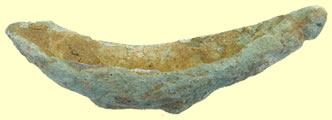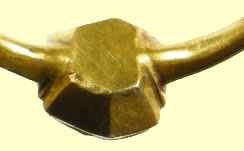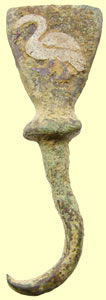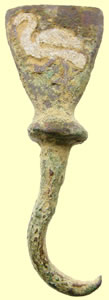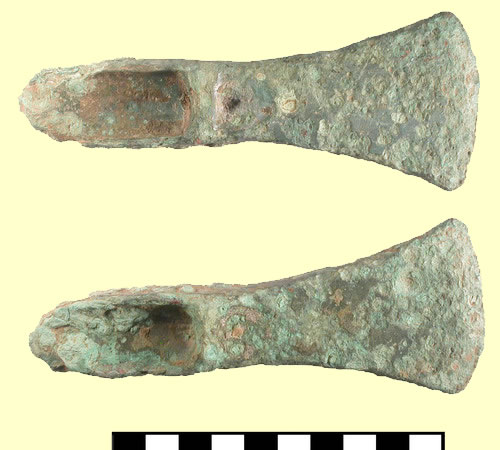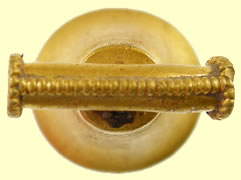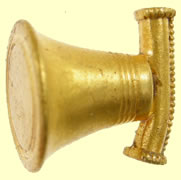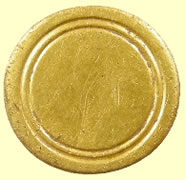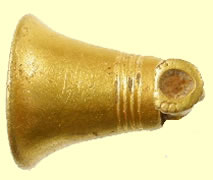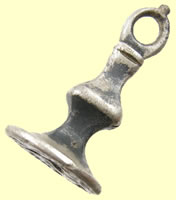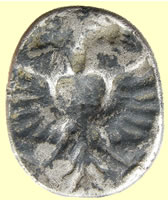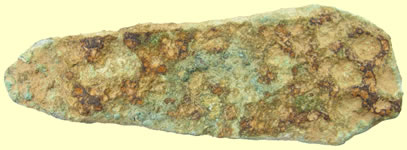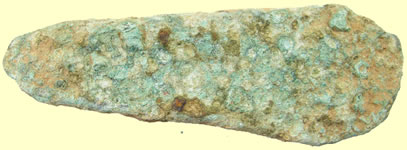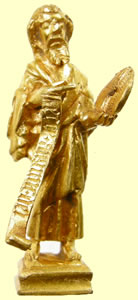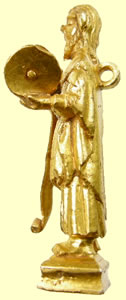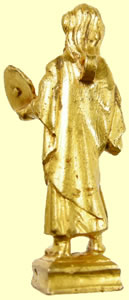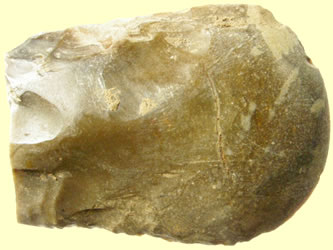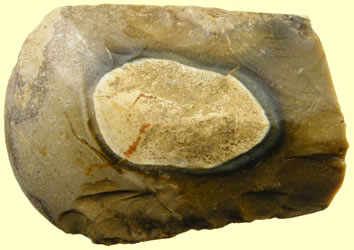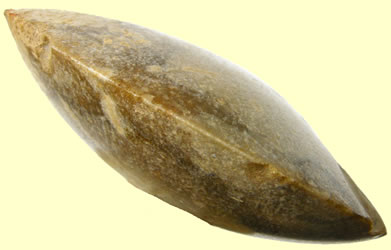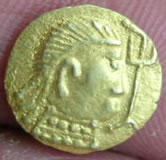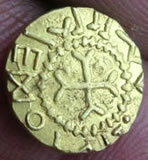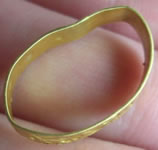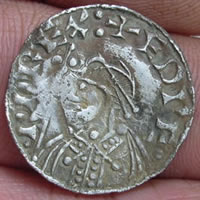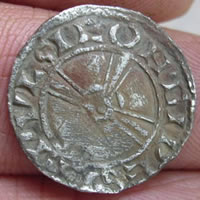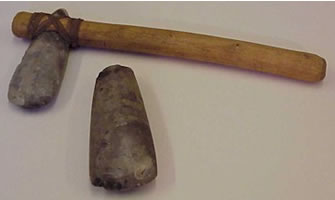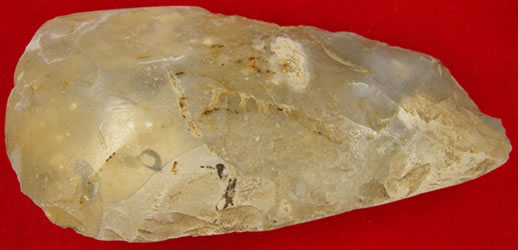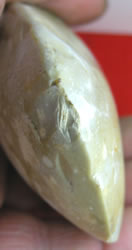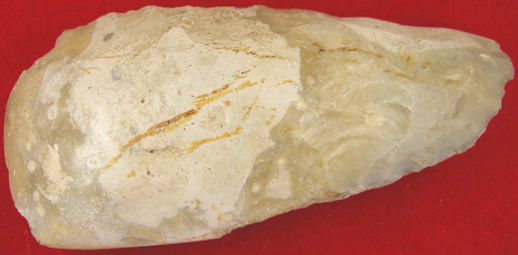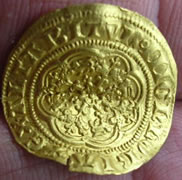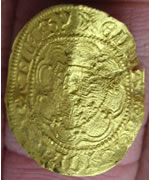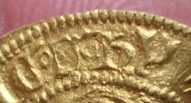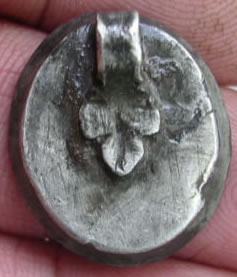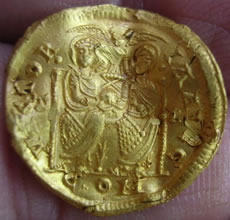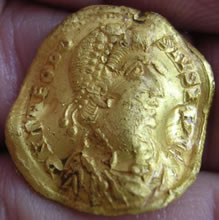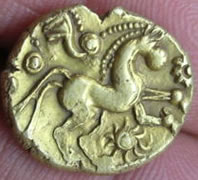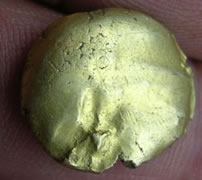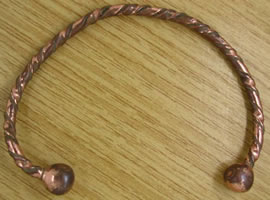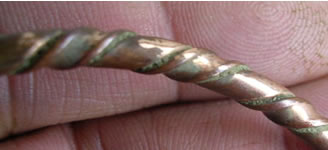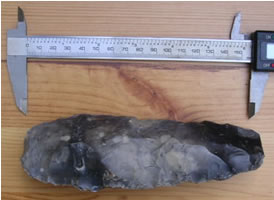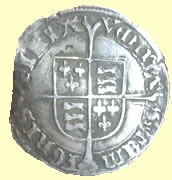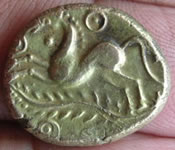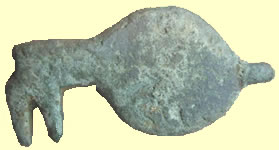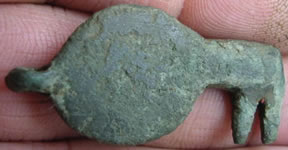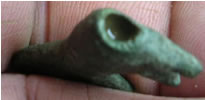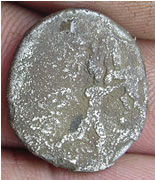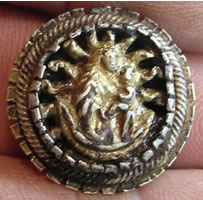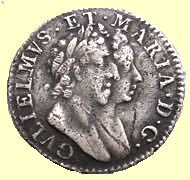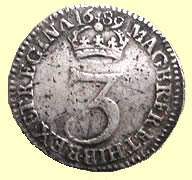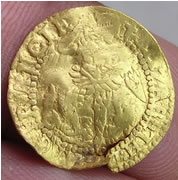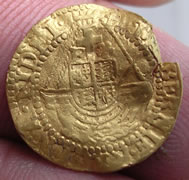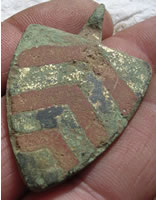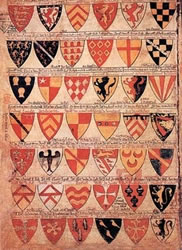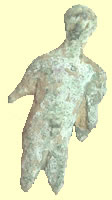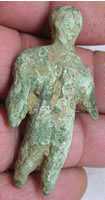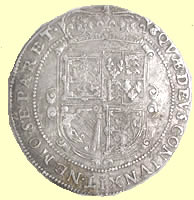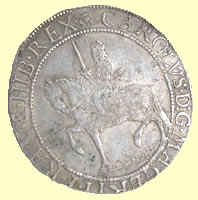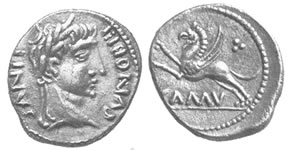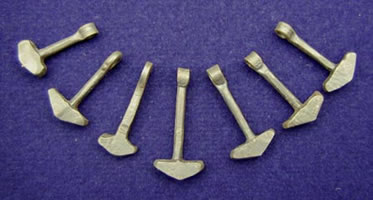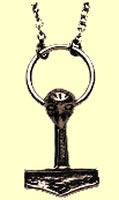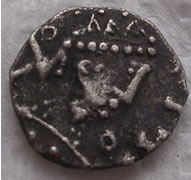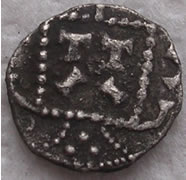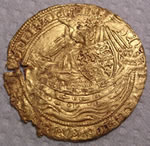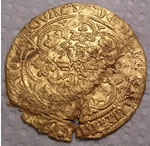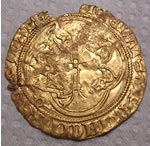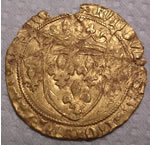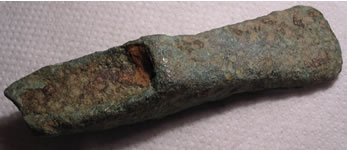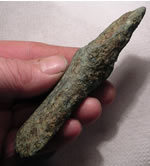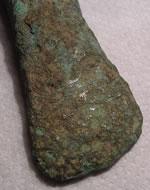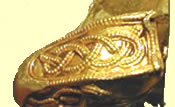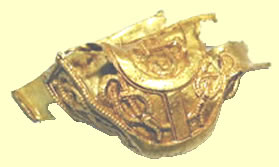

Metal detecting holidays in England with the World's most successful metal detecting club.
Twinned with Midwest Historical Research Society USA
Find of the year 2004-2023This updated page is found on the awards page - Click here2011/12 |
At the end of the season every guy that comes here gets to vote for his personal favourite find throughout the season (not his own finds of course) The find with the most votes gets the holder a free weeks full board detecting next season and the engraved Roman jug, not forgetting his name on the role of honour shield ! These are not the definitive list but are a few of my current favourites, guys can vote for any finds that are on our club site for the season 2011/2012.
Merovingian tremissis of the 7th century Saxon gold coin - this is part of an existing hoard and reported as hoard to the museum Sent to Fitzwilliam museum for ID and recording 1.18g, 11.73mm
Merovingian tremissis of the 7th century Saxon gold coin - this is part of an existing hoard and reported as hoard to the museum Sent to Fitzwilliam museum for ID and recording This sucker is tiny and mint 1.30g, 10.21mm, totally different from the others Many thanks. A preliminary trawl of the works of reference has not yet I have not recorded this in EMC as it is probably not a single find. Best wishes, Martin
Cleaned 8thC Saxon Offa Rex silver penny - in 'cooker' to remove crust sent to Fitzwilliam museum for ID and recording Different type pf the other we have found 16.22mm,1.31g
1327 Edward III hammered gold half noble - Cross 3 - E in centre of reverse cross Obv EDWARD DEI GRA REX ANGL 24.79mm, 3.89g
10-40 AD Cunobelin Celtic gold full stater - very rare bigga type
5.51g, 16.86
Monster find Romano/British Chariot top Terret ring - this is enormous with gold, red enamelled 65mm high
Stunning Roman mount with face decoration
Saxan Offa Rex penny This is a very interesting find, providing a new type for the Heavy Coinage of Offa. It is a coin of the London moneyer Eama, with some similarities to Chick type 207 (Blunt 90; a unique coin from the Delgany hoard), but the triple-stranded cross is new. The first three letters of the moneyer's name (EAM) are clearly visible in the images, and you might be able to see whether the final A is visible on the coin itself. Presumably the obverse, which almost entirely obscured by the bending of the coin, has M / OFFA / REX in three lines, of which the M is visible in the images. I have recorded this as EMC 2012.0121. Best wishes, Martin
Another staggering find - Huge Saxon/Viking medallion 11.20g, 27.95mm
C 8thC Saxon decorated and gilded helmet 75.02mm L
Huge C 9thC Viking 'Ladder of life' strapend - these are well known for being unusually large 70.23mm L x 28.15mm W, 43.24g
Monster find - Early medieval and possibly Saxon gold ring - reported as treasure to museum "DEBAL GUD GUDANI +" which is Gothic, meaning "God of Gods" Interesting hand punched lettering which has a barred A with additional top bar like on short cross coins of Class7 and an unbarred A also on the ring. 4.22g, 4.49mm H x 22.59mm W
C 1stC AD Celtic drinking vessel spout - face decoration 34.94mm W x 20.63mm L - 27.20g
50 BC Canti - 1/4 Celtic gold coin -2.06g, 10.43mm - - Uninscribed 'P' gold -'Trophy' type VA147 Cantiaci / Cantii This Celtic tribe occupied the south-eastern corner of Britain, probably from the second century BC. Its territory traditionally comprised Kent, eastern Surrey, East Sussex and London south of the Thames. The Cantiaci, or Cantii, were bordered across the Thames by the Catuvellauni and the Trinovantes, although the former may only have expanded to the Thames between 54-30 BC. It is unclear who controlled the north bank of the Thames before that - perhaps a minor tribe that was later absorbed by the Catuvellauni. To the west were the various peoples that made up the Atrebates, including the Regninses. Like many of their neighbours in the south-east, the Cantii were Belgic people from the North Sea or Baltics, part of the third wave of Celtic settlers in Britain. They formed a recognisable territory which may not have been a single unified kingdom until the start of the first century AD, but which instead appears to have been several smaller kingdoms which operated as a confederation in times of trouble. The four individuals who flourished around 55 BC may have been rulers of each of the Cantii kingdoms, perhaps operating together under the authority of Cassivellaunus of the Catuvellauni. Certainly Julius Caesar recorded the Cantii as having four leaders who were kings in their own right. The Cantii at this time were strongly influenced by their Belgic neighbours, the Atrebates, who were more recent arrivals in the country. Their customs were also much the same as the Celts of Gaul, and they were wont to die their skins with blue woad which made them look more terrifying in battle. This custom died out south of the Antonine Wall following the Roman Conquest. That conquest may have caused some of the Cantii to flee northwards where a tribe called the Decantae was noted, just once, by the Romans in Pictland around AD 140.
211 BC Roman silver coin - equals the oldest ever coin found in Britain This dates, as far as I can tell - since no trace of symbol has become visible beneath the horses or between the heads of the Dioscuri - to the earliest issue of actual Denarii, as distinct from the earlier Drachma-denominated silver coinage. It dates to the period 211-206 BC (according to the most recent scholarship on dating) and would be RSC # 2 (Roman Silver Coinage) - if that catalog number gives you some idea of how close to the beginning of the book it's found. This first coinage was anonymous, lacking even symbols to potentially indicate via association (or pun) the names of the families of moneyers. This is actually the 3rd type produced (so far as I can tell) "ROMA" in the exergue of this specimen appears to be in relief. On the very earliest ROMA was incuse, and a transitional type had ROMA partially incuse and partially in relief. The general types, however, the helmeted head of Roma, inspired by (and, frankly, copied from) the helmeted head of Athena on Corinthian didrachms) with "X" mark of denomination (10 Asses of bronze to the silver Denarius - later it would be re-tariffed at 16) and the Dioscuri, Castor & Pollux, galloping right with levelled lances would be among the very most common devices used on denarii over the next 150 years. When there was no specific bit of history or family fame being related on a moneyer's denarii, this was one of the 3 main "stock" types, along with Jupiter driving a quadriga and Victory driving a biga. I believe this is the earliest Roman coin you folks have turned up, to date. It is, at least, the earliest I recall being forwarded to me for identification. With the exception of the slightly earlier (and very much more rare) "Romano-Campanian" Quadrigati (Didrachmae), Drachmae and Semes, this is about as early as you can go in the "Roman" coin series. Mark
17.81mm, 3.28g
Amazing huge 11,000 Stone Age flint axe head - this is beautifully crafted with a thumb slot for easy holding
------------------------------------------------------------------------------------------------------------------
Winner of season 2010/11 Ill Mark's Roman gold coin
13thC Medieval gold ring bezel with black sapphire - reported as treasure to museum 1.05g,11.13mm
1st to 4thC Roman decorated gold ring with green stone - reported to Colchester museum as treasure 20.01mm,1.43g
Saxon silver penny of Æthelred II 978 AD sent for recording and ID 1.22g,20.34mm This coin (EMC 2011.0084) belongs to the First Hand type (note the absence of a sceptre on the obverse and the plain sleeve without a curve at each side). The Benediction Hand type has two fingers bent in blessing. The moneyer is probably Eadsige or Wynsige. With thanks, Martin
Roman gold ring -decorated with hanging fruit and vine - reported as treasure to museum 1.46g, 24.49mm
Stunning complete medieval decorated purse bar and swivel
10-40 AD Northern silver of Cunobelin - AR unit Hobb 1868 Obv 'CVNO' inside double rectangle, all inside wreath pellet boarder Rev winged griffin r.,below 'CAMV' inside quad.o,pellet boarder
Roman gold coin - sent for ID 19.6mm, 7.81g Oh man, is that ever beautiful!
That is, of course, an Aureus of the emperor Claudius (41-54 AD) the presumed-to-be "simple-minded", somewhat disabled uncle of Caligula. He was seized upon by the Praetrorian guard as a tractible replacement after they had murdered Caligula, his wife and child. It turned out that Claudius was smarter than most of the Julio-Claudians and had merely allowed everyone to think he was simple-minded. This allowed him to hide in the background, out of the way of the endless palace intrigues. The successful ruse evidently kept him from suffering the sort of "mysterious" death which seemed to stalk all the other Julio-Claudians who might be in-line for or have some claim to being emperor. Once in power, he showed that far from being "simple", he was a shrewd and canny politician and proved to be a benificent ruler as well, righting a lot of the wrongs perpetrated by his evil nephew. Eventually, however, his love of women was his downfall. Marrying his neice, Agrippina Jr., the last of his succession of unfortunate marriages, he had inadvertantly adopted and brought into his home one of the true vipers in the Imperial nest, her son, the future emperor Nero. It is assumed that Agrippina, on her son's behalf, (or possibly even Nero himself) was responsible for feeding him a dish of deadly poisonous mushrooms. This removed the last impediment and cleared the way for Nero to become emperor.
This is one of the more common reverse types for Claudius' aureii, the PACI AVGVSTAE or "The Emperor's Peace". It has an interesting reverse type, too. Rather than Victory, whom you might assume was the winged character on the reverse, this is "Pax-Nemesis" performing a gesture associated with a uniquely Roman bit of superstition. She is drawing out a fold of her gown in what is called in some delicate circles an "Apotropaic gesture" - in other words, she's spitting on her own breast, which, like throwing a pinch of spilled salt over one's shoulder or touching wood, was a common superstitous custom among Romans and meant to deflect bad fortune.
This piece was struck in 41-42 AD at the imperial mint for precious metal coins, which happened at the time to be in the provincial capital at Lugdunum (modern Lyons) and coincidentally was also where the future emperor Claudius had been born.
This is actually one of the more common types of early Roman Imperial Aureii, but "common" here is all relative - particuarly in recent months, Roman Aureii have been bringing astonishing amounts of money - I wouldn't even venture a guess as to what the current market value of this piece might be - most likely at least in the 5-figures range of GBP's, Euros or Dollars.
Mark
Early 70BC uninscribed 'Q' Gold - 'Remi 'Type Celtic gold qtr stater Rev .horse r.,from neck pellet ring var.d above pellet in ring,flower j & pellet-in-ring,before 4 pellet-in-rings,below wheel f & pellet, below & above tail pellet-in-ring triangle 1.34g,14.86mm Hobbs 482
Middle Bronze age socket spear head 1500-1100 BC 85.26mm L x 25.57mm W - socketed dia 18.88 mm
Saxon C600-775 AD Silver Sceat - sent to Fitzwilliam museum for recording and ID 1.23g, 12.22mm
Excellent heavy full stater - 70 BC Early uninscribed British 'A' Gold stater Westerham type Disjointed horse, pellet below 19.76mm, 6.13g
Missing part of the Stunning 1stC BC to 1stC AD Iron Age Celtic enameled clothing fastener found last week
Mint 13thC vessica seal matrix Lamb and tree of life S' ROGER' ( seal of Roger) ALEE ODOC
As usual this coin (EMC 2011.0059) is Merovingian and not Anglo-Saxon, but an important find nonetheless. We have recorded two cut halves of Anglo-Saxon gold shillings in recent years, and a cut half of a Series B sceat, but this coin is noticeably more than a half (between two-thirds and three-quarters), so it may have been cut up as bullion. This is developing into a really interesting hoard. Best wishes, Martin I should have mentioned that there is no obvious match in the works of reference on Merovingian coins, but the inscriptions are legible, which gives some hope of identification eventually. Martin
Monster find - 9th/10thC Saxon/Viking sword scabbard chape- gold on silver This style better matches known Viking types 11.96g, 39.58mm L
Saxon gilded silver T brooch
BC Roman republican silver - sent for ID 3.23g,20.52mm
If these great ID's were not enough Mark Lehman sends back the ID of the Republican silver Roman coin found by Dave and it is a real oldie at 115BC This is a very interesting piece - both for the un-encrusted condition in which it was dug, and as a type. Dating to about 115/4 BC., this was an anonymous type produced well after the time when moneyer's names had become standard on the coins. The obverse is Roma wearing the typical winged and crested Corinthian-style helmet; an "X" to indicate denomination (a silver Denarius was worth 10 Æ Asses at the time) behind the head and ROMA beneath. The reverse shows Roma seated right on a pile of shields and holding a transverse spear. Birds, one per side, fly in the field; and to the right, the she-wolf suckles the twins, Romulus and Remus, so there's a lot going on here, symbolically.
David Sear writes in RC&TV, 2000: "An issue lacking the moneyer's name is surprising and noteworthy at such a late date. The omission must have been his own decision and not the result of a change in government policy. Remarkably, this distinctive reverse type was revived almost 200 years later on an aureus of Titus."
So, it's not the earliest piece your diggers have found, but it's still pretty early. Moneyers' names had become standard on the denarius coinage around 155 BC. and for the previous several decades most coins had born symbols relating to the moneyer's name or family in some way. This isn't a particularly rare piece, overall, but it is an unusual type.
The references for this piece are: RSC 176, CRR 530, RCC 287/1 & SR 164.
Mark
c 8thC Saxon gold coin - sent to Fitzwilliam museum for recording and ID Unusually thick coin for a Saxon 1.31g,9.51mm x 1.61mm thick
2000 BC Early Bronze Age flat axe - 95.92mm L x 43.11mm W
Open mouthed beast zoomorphic type - red eyes
C8th to 10thC Viking style zoomorphic dagger chape 54.08mm L, 29.85g - red and green enamel remains
1761-1780 18thC decorated silver clog fastener Hester Bateman First recorded English woman silversmith London Assay office Hester Bateman is without doubt the most popular and renowned of all women silversmiths. Yet Hester's career as a silversmith was never intended. Widowed at the age of 51, she inherited her husband's small workshop practice and for the next thirty years, this unlikely shrewd business woman, grew the workshop into a thriving silver manufacturing firm. Hester Bateman was born in 1704 in Clerkenwell, London (England), and married John Bateman (a goldsmith) in about 1725. They had six children; John, Letticia, Ann, Peter, William, and Jonathan. The family lived at 107 Bunhill Row in the Parish of St. Luke in North London for more than a century. John and Hester purchased the houses on both sides of theirs, and two of the children occupied those homes in later years. Although his sons Peter & Jonathan were both doing their silversmithing apprenticeships, when John Bateman died in 1760, he bequeathed all his tools to Hester suggesting that she was already an accomplished silversmith. However, even with the skills of the trade, Hester had no small task ahead of her to continue the business. In these times, women-owned businesses were generally not accepted, and the industry was highly competitive. Unperturbed, Hester registered her mark of a scroll HB at Goldsmiths Hall in 1761 and aided by her son's Peter and Jonathan along with Jonathan's wife, Ann, the business boomed. In 1790, Hester finally retired at the grand old age of 81. Sadly, the following year her son Jonathan died, leaving Peter without his two long term partners. He turned immediately to his sister in law Ann, making her a partner in the business and registering their joint mark in 1791. From then Ann became the driving force in the business until her retirement in 1805. In 1800, Jonathan and Ann's son, William, became a partner in the family business, completing possibly the most famous of all silversmithing dynasties. Unlike most silversmiths who specialised in just one area of production, the Batemans were masters of many, producing fine wares right across the board. The main reason for their success was due to Hester's attention to design, detail and quality. All the pieces that left the workshop would be inspected to the highest standard and with this attitude the business grew. Many pieces of Hester Bateman's silver show identifying characteristics such as bead detailed edges and fine designs of bright-cut engraving. They received many commissions from The City Guilds, various religious establishments, and private individuals
C14thC medieval emerald gold ring - reported as treasure to the museum 0.48g, 14.54mm
1stC BC Uninscribed 'L' 'Waddon Chase type' Celtic gold full stater - sent to CCI for recording 5,86g, 1.6mm 'These coins are probably not very much earlier than the Addedomaros staters - it all depends really on when one dates the Addedomaros issue. It seems fairly certain that the Whaddon Chase staters could be from the later stages of the Gallic War, say about 54 BC at the earliest; they could be a little bit later, but are unlikely to be after say 40 BC at the very latest.' Dr Philip de Jersey
1stC BC Celtic gold 1/4 stater- sent to CCI for recording and ID Pictures as dug and after partial 'cooking' 14.46mm, 1.40g This one has been allocated the CCI number 10.1044. It is a British G “Clacton” quarter, Hobbs 192 (he mis-identified it as an H quarter for some reason). At least 44 known before this – from right across the area most people would label as territory of the Trinovantes... Ian
Almost cleaned - still 'cooking' it outh Eastern Celtic silver unit of Amminus circa 1stC - sent to CCI for recording 1.33g,1.5mm Adminius was probably the eldest son of Cunobelin, who was given the administration of Cantium by his father c.AD30. Inscribed coinage has been found throughout the canton, bearing the name AMM INVS, and a mint mark DVN, probably indicating an administrative centre at Durovernon Dvrovernvm Cantiacorvm (Canterbury, Kent)Native pre-Roman settlement on the Stour in East Kent, later cantonal capital served by a port three miles down the Stour at Fordwich. Amminus (Adminius) minted coin bearing a mint-mark of DVN, which is thought to be an abbreviation of Durovernon, with the implication that he had a mint here.
61.54mm L x 35.8mm W, 54.89g Stunning early medieval dagger quillion - finger guard is decorated with a runic inscription I checked all the runic styles and it matches Norwegian the best - one for the museum Norwegian Futhark
Saxon
Monster relic - 4thC Roman gold coin contemporary forgery 1.28g, 17.59mm That's a very interesting piece - however, even though counterfeits came into existence about 3 hours after coins were invented, this isn't a counterfeit. It's not an ancient forgery or counterfeit made to deceive, at any rate. It's also not an "official forgery" (like the plated Athenian Owls) and is unlikely to be a simple contemporary copy with some local, semi-legitimacy, because there simply was no gold coin of this type.
Typically, fourres of Roman gold coins date to a somewhat earlier time - primarily the 1st century - I don't think gold circulated much after that time. It was used as a store of value or for major transactions like land purchases, but people weren't carrying it around as a regular thing in the 4th century. The fact that almost all the gold of this era ever found is virtually uncirculated attests to the lack of circulation. Those 1st century BC & AD fourres were typically made by wrapping a base (generally copper) core with a fairly thick foil of silver (the vast majority of fourres are silver) or gold which was "soldered" to the core by introducing a layer of a powdered flux and heating the resulting blanks before striking. Except when the die-sinking was so amateurish that it's impossible to miss, or the core becomes exposed, these are fairly believable - except that their weight is generally low for the type. However, this expensive, labor-intensive foil-wrap technique had gone just about totally out of existence in the late 2nd, early 3rd century, since the silver it was made to copy had become so debased that the official "silver" itself had to resort to surface-enrichment techniques to pass for silver. Those same techniques were a lot cheaper and easier for the forgers, too, so you find "silvered" fourres beginning at this time.
However, this appears to have been plated by electrolysis (possibly a pre-electric, strictly chemical process) or some other type of plating, rather than wrapping or selective reduction (surface enrichment) technology. It's obviously been buried a while - the edge-chipping seems consistent with contemporary types you find (these date to the period 330-340) and the host coin appears to be a completely legitimate piece - RIC VII 561 from Trier. This puts it in an "after-market plating" situation. And the reasons people plate coins are numerous, and being personal, are seldom easily explained. This doesn't seem, strictly speaking, to be a "modern" plating job (post 1500), but it really could have been done at any time and for any reason - except to be a "counterfeit" by the strict definition of a counterfeit.
The VRBS ROMA / shewolf & twins reduced folles were silvered when issued - although the silvery coating seldom survives to the present day. We nevertheless need to be sure this isn't discolored silvering. If it was definitely an applied, "golden" coating (gold or otherwise), it could have been done at any time.
Mark
1stC BC to 1stC AD Celtic enameled clothing fastener - 36.64mm L Date from: 100 BC -------------------------------------------------------------------------------------------------------------------------- 2009/10 Season with winner
Merovingian tremissis of the 7th century ( Find of the year winner 2009/10) 1.26g,15.08mm This coin (EMC 2010.0131) is a Merovingian tremissis of Coutances (dep. Keep looking. Martin
c 600/800 AD English Saxon gold coin send to Fizwilliam museum for ID and recording Not shown in any book I have ??? 1.35g, 13.87mm
18.74mm, 5.62g Outer Band - In memory of Inner inscription - Anna C Round Ob 5th Ap 1822 Maker TM -18 carat Sheffield hallmark 1829
Stunningly beautiful - Romano/British bronze razor back pig/hog offering ? red enamelled eyes - 65.56mm L x 39.9mm H 148g
Best condition Roman silver I have ever seen dug- next to fresh water spring ! Probably an offering Sent off for ID 16.3mm,3.39g
Ark Gary's 11,000 BC flint hand axe
Fantastic find 1stC BC Celtic bucket mount - The bird probably a raven would be one of a series used as decoration around the top of the bucket. The bucket was used in sacrificial or religious ceremonies In Celtic mythology birds were represented as the messengers of the gods
5th-6th century AD Saxon gilded saucer brooch - running spiral design East Anglian type
Fantastic circa 13thC Medieval seal matrix with heraldic shield impression - this seal is first I have seen with additional decoration on the 'bell' top It will be interesting if we can find the family crest and who it belonged to
7th century Saxon dragon headed silver strap end - reported as treasure to museum
35.89mm L, 2.61g
As dug and nearly cooked - 3.40g, 18.81mm
AR Denarius Serratus, 82 B.C. |
Possible 50BC Remi tribe Celtic gold 1/4 stater - sent to CCI for recording and ID 1.14g,12.55mm This is a very nice find, the so-called 'Bishop's Wreath' type, an early North Thames quarter that's related to late Whaddon Chase staters, especially VA 1498-1502, struck in the Essex region. The only publication of this type was in the British Numismatic Journal for 1998, Coin Register no. 14. I don't have the exact numbers to hand but it's listed as excessively rare in the draft version of Chris Rudd's forthcoming replacement for Van Arsdell, which means 2-5 known; I'll let you know how many there are next week after I've checked the cards. The late Whaddon Chase staters it circulated alongside are reasonably closely dateable to around 50-40 BC so it seems to fit in with the other early finds from *******. I've given it the CCI no. 09.3512.
All the best
John
|
1346-1361 Edward III gold half noble - Closed E at centre of cross - Cross 3 - Pre treaty Obv EDWAR D GRA (DEI G) REX ANGL AZ FRANC 25.10mm, 3.80g |
957 AD King Edgar -Saxon hammered silver penny 18.29mm, 0.59g- sent for confirmation of ID and recording to the Fitzwilliam museum Many thanks for this find, which I have recorded as EMC 2009.0377. It is a coin of Edgar's Bust Crowned type, with the last letter of the king's name, R, visible on the obverse. Unfortunately the remaining portion of the reverse inscription is a garbled version of MONETA (MONEAT), and consequently the mint and moneyer are uncertain. Best wishes, Martin |
Taco'd Circa 1350 Edward hammered gold 1/4 noble - Cross 3 -Needs straightening to ID exact type from rev shield. Obv + EDWARD DEI GRA REX ANGL Rev 18.92mm. 1.9g |
Medieval gold ring - full inscription inside and out - reported to Colchester museum as treasure inner - PEULET Z (FRENCH NAME ) Outer - SF UNY
17.18mm, 4.17g |
Monster find -Circa 1300C Bronze age gold open backed triple banded gold ring 3.48g, 13.73mm dia x 6.74mm H Reported to Colchester museum as treasure |
Medieval gold ring with sapphire - 24.12mm dia, 11.42g - report to Colchester museum as treasure |
1243 AD Medieval harness shield pendant of De Clare 'Found more on De Clare-- seems there was a Gilbert "The Red" (red haired) de Clare & son of Richard-- was one of the Earls of Gloucstershire (7th , I think) and had a whole bunch of other lands in 20 counties in Eng and Ireland. Joined the Montfort rebellion against the king. Married a jaon (Johanna) daughter of Edward II Longshanks , she was born in Acre - the site in the holy land where the Crusaders / Templar's lost it all . He was born in 1243'. |
995-7 Late transitional period - Æthelred II 'crux' type South Eastern mint bust type Fig 7 - Eadpold, moneyer Bar headed bust left Voided short cross with C,R,V,X in angles Obv + AEDELRED REX . ANGLO\X, written with sperate R & X Rev + EADPOLD M : U CAENT - Cantebury mint Æthelred the Unready, or Æthelred II,(c. 968 – 23 April 1016), was a king of the English (978–1013 and 1014–1016). He was a son of King Edgar and Queen Ælfthryth. His reign was much troubled by Danish Viking raiders. Æthelred was only about 10 (no more than 13) when his half-brother Edward was murdered and was not personally suspected of participation. But as the deed occurred at Corfe Castle by the attendants of Æthelred's mother, it made it more difficult for the new king to rally the nation against the invader, especially as a legend of St Edward the Martyr soon grew. Later, Æthelred ordered a massacre of Danish settlers in 1002 and also paid tribute, or Danegeld, to Danish leaders from 991 onwards. In 1013, Æthelred fled to Normandy and was replaced by Sweyn, who was also king of Denmark. However, Æthelred returned as king after Sweyn died the following year. "Unready" is from Anglo-Saxon unræd, meaning ill-advised |
995-7 Late transitional period - Æthelred II 'crux' type South Eastern mint bust type Fig 2 - Eadpold, moneyer Bar headed bust left Voided short cross with C,R,V,X in angles Obv + AEDELRED REX . ANGLO\X, written with seperate R & X Rev + EADPOLD M : U CAENT - Canterbury mint Æthelred the Unready, or Æthelred II,(c. 968 – 23 April 1016), was a king of the English (978–1013 and 1014–1016). He was a son of King Edgar and Queen Ælfthryth. His reign was much troubled by Danish Viking raiders. Æthelred was only about 10 (no more than 13) when his half-brother Edward was murdered and was not personally suspected of participation. But as the deed occurred at Corfe Castle by the attendants of Æthelred's mother, it made it more difficult for the new king to rally the nation against the invader, especially as a legend of St Edward the Martyr soon grew. Later, Æthelred ordered a massacre of Danish settlers in 1002 and also paid tribute, or Danegeld, to Danish leaders from 991 onwards. In 1013, Æthelred fled to Normandy and was replaced by Sweyn, who was also king of Denmark. However, Æthelred returned as king after Sweyn died the following year. "Unready" is from Anglo-Saxon unræd, meaning ill-advised |
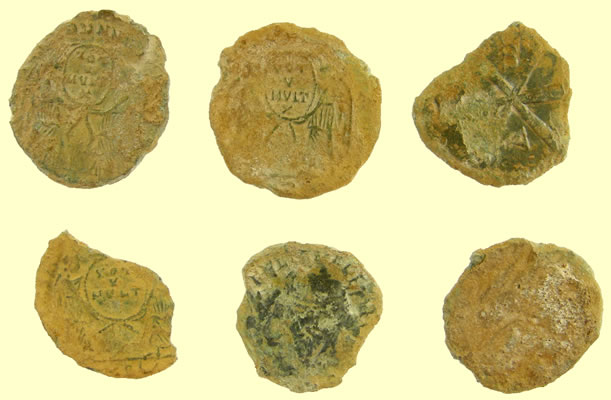 |
Roman bronze hoard |
Medieval enameled religious belt end- IHS, initials for IESUS HRISTOS SALVATOR, Jesus savior of man - some red and blue enameling remains |
As dug to latest 'cooked' 69AD Otho silver Roman coin I still have this coin in the 'cooker' to see I can get more obverse detail One of your two silver coins here is VERY interesting. I'm 95% sure it's Otho - one of the three short-lived successors of Nero in 69 AD. When Nero committed suicide, he had been such a bad, totally self-involved ruler that there wasn't any semblance of an orderly administration to turn-over the reigns of government peacefully to a successor. Three major contestants arose and succeeded each other in short order - Galba, Otho and Vitellius - before Vespasian (who was off in Palestine biding his time, laying seige to Jerusalem and sacking the Temple) on seeing that they'd all succeeded in wiping one another out, returned to Rome as the victorious general and founded the Flavian dynasty (which built the Colosseum over the remains of Nero's Domus Aurea, etc.
Otho, himself, was around for only about 3 months (15 Jan - 17 April, 69) total, so his coins (he struck no Imperial AE, incidentally, only gold & silver) are among the rarest in the "normal" series of Roman emperors. You might recall me getting fairly excited when one of your diggers turned up a Galba (Otho's immediate predecessor, and not quitte so rare) a couple years ago.
I can't tell from the reverse just what it was when it was minted. It appears to be a standing deity or personification, but there's just not enough detail to have a good idea who was intended. Very interesting, however - one sees so few Othos in general. |
|
Find of the year 2008/9 Season 2007 - 2008 |
|
At the end of the season every guy that comes here gets to vote for his personal favorite find throughout the season (not his own finds of course) The find with the most votes gets the holder a free weeks detecting next season and the engrave Roman jug, not forgetting his name on the role of honor shield ! These are not the definitive list but are a few of my current favourites, guys can vote for any finds that are on my site for the season 2008/2009.
1stC BC Celtic bronze wode grinder - suspension loop type worn around the neck 51.56mm L x 10.13mm W , 12.27g
Black Onyx Medieval gold ring 21.93mm dia, 2.51g - this is currently with the British Museum - Treasure case No 2008 T58
Stunning medieval gilded red and white enameled hanger 61.05mm L x 21.27mm W
Bronze Age (c.1500-1400BC) cast copper alloy primary shield pattern palstave, dating to the Acton Park Phase. It is damaged and incomplete, with active copper corrosion. The butt end is missing, and the flange damaged. There is a prominent stop ridge, with a shield shaped depression just below on both surfaces. There is a casting flaw just above the stop ridge on one surface, which has created a small void, approximately 10mm deep, and 3.6mm by 2.6mm wide. The blade expands out into a concentric cutting edge, which is extremely worn. The axe is 135.10mm long, and is 24.95mm wide, 7.95mm thick at the butt end, with the damaged flange increasing the thickness to 21.21mm. It is 27.73mm wide, 27.16mm thick at the stop ridge, and the cutting edge is 53.84mm wide. The axe has a dark green patina, however most of the original surface has been removed, leaving a pitted, light green surface. A casting seam is visible through the corrosion on one side.
Saxon solid gold hanging pendant ? - 2.65g, 11.95mm H x 10.68mm dia x 11.68mm W - currently with the British museum
Silver seal matrix – double headed eagle with heart 5.02g, 25.09mm L x (13.79mm x 10.98mm seal head)
Earliest flat axe there are 2000BC - It's size suggests it may well be a chisel or scraper 68.50mm L ,24.35mm W x 4.72mm T 30.11g
Stunning medieval gold statue pendant - C13th judging by the Lombardic script on the scroll . This is probably to do with the Catholic church (DEI) and one of the members suggested FRCO is St Francis
Script reads FRCO ++SMYUNC +DEI - currently with british museum 32.80mm H ,11.46g
Neolithic (3500-2100BC) polished axe head, knapped from mid-grey flint. The surface of the axe is not fully polished, leaving a large amount of scaring along the edges of the axe from the shaping process. The butt end is damaged and incomplete, and the break appears worn. There is a partial hinged termination where the axe has been broken. The cutting edge is in good condition along most of its length, with a few small breaks to one side. The blade itself is not worn. The axe has a double convex cross section. In profile, the axe is widest towards the cutting edge, tapering in thickness towards the break. The axe is 78.74mm long, 57.08mm wide at the blade end and 44.85mm wide at the broken butt end. It has a maximum thickness of 22.56mm. Weight 124.31 grams.
-------------------------------------------------------------------------------------------------
27th April 2008 Sal wins find of the year
English Saxon Thrysmas gold coin - 'Witmen type' c620 -650 AD - Recorded on Fitzwilliam museum Corpus database as EMC 2007.0302. 1.26g, 11.46mm Val was wearing his 'hat vid cam' when he dug it so watch the video here
2nd place was this beautiful medieval gold ring found by Idaho Travis which is currently with the British museum going through the treasure process - 1.23g, 19.50mm dia
3rd place was this was this rare Saxon silver coin found by Oregon Clarence 1050- 1053 Saxon - Edward the Confessor hammered silver penny - expanding cross type - heavy coinage ? Obv EDWERD REX : + Rev (Wulfsige) ON GIPESWIC (Short cross voided with expanding limbs) - IPSWICH MINT (GIPESWIC) EMC 2008.0136. 1.63g, 19.87mm 'I have recorded it as EMC 2008.0136. The portrait with two toggles on the mantle certainly differs from the types illustrated in North, but these illustrations were drawn in the the early 1960s to show the main types only. There are many variants, and the three other coins of this type, mint (Ipswich) and moneyer 'This is extremely interesting. It is very promising. Gareth Williams has commented that the Ipswich coin 'seems to be from the same dies as one of our [British Museum] coins (1950,6-5, 1) and the same variation in the design is also found on two different obverses of Bruninc of Ipswich. However, it isn't a purely local variation, as the same bust appears on selected coins of Colchester, Gloucester and London, and a related variation at Dover, although these represent the minority of dies from the mint in each Martin Voting was very difficult this season as there were just so many finds to choose and was spread across 13 finds. Another find of note was Penn Christies 11,000 BC Mesolithic axe head.
|
||||||||||||||||||||||||
|
||||||||||||||||||||||||
c 3500 BC Neolithic stone axe head - 123mm L x58.12mm W x 34.5mm T , 257g |
||||||||||||||||||||||||
Rare 4thC silver Roman I have the siliqua narrowed down to a single mint - Milan - and between two emperors - Arcadius and Honorius. Now, the part of the legend that would tell us which of the two it is, of course, is off-flan - Murphy's Law of ancient coins in action. What we can read clearly on the obverse is the 2nd half of the obverse legend: "...VS PF AVG"
Unfortunately, both Arcadius' & Honorius' names break in the same place and have the same number of letters:
DN ARCADI - VS PF AVG
and
DN HONORI - VS PF AVG
So I think you can easily see where there's room for ambiguity here. Aside from a few letters the names, the coins have identical types, mintmark-styles, etc. By this time there was little energy being devoted to realisim in portrature, so we don't get much help there either - if pressed, I'd have to say I think it might slightly favor the portrait in a photo of an Arcadius siliqua in my book.
So, take your pick, it could be either - looking at the lower seriphs of the 1st half of the legend isn't conclusive - if the 4th character is an "O"", it's Honorius - if an "R, Arcadius. It seems to me, perhaps, slightly more likely to be an "O". - So, we're tied 1 to 1 on the vague, ambiguous clues, too.
In either case, the reverse is VIRTVS ROMANORVM - Roma seated left on cuirass, holding Victory on globe and inverted spear. In the exergue: MDPS for Milan.
If Arcadius (383-408 A.D.), it's RSC 27b, RIC 32b.
If Honorius (393-423 A.D.), it's RSC 59b, RIC 32c
Mark |
||||||||||||||||||||||||
Fourth coinage 1356-61 Edward III hammered gold 1/4 Noble Type C Annulet stops 1.96g, 20.36mm Obv shield quartered with the arms of England and France within a treassure of eight arches - EDWARD GRA REX :ANG. . HY Cross 3(4 ) Rev EXALTABITAR IN GLORIA
Annulet stops |
||||||||||||||||||||||||
Stunning c 13thC Medieval engraved gold ring found by Idaho Travis - reported as treasure to the museum 1.23g, 19.50mm dia |
||||||||||||||||||||||||
Solid silver medieval vessica seal 62.1g, 21.96mm L x 18.81mm x 5.51mm W (excluding hanger) |
||||||||||||||||||||||||
3rd place was this was this rare Saxon silver coin found by Oregon Clarence 1050- 1053 Saxon - Edward the Confessor hammered silver penny - expanding cross type - heavy coinage ? Obv EDWERD REX : + Rev (Wulfsige) ON GIPESWIC (Short cross voided with expanding limbs) - IPSWICH MINT (GIPESWIC) EMC 2008.0136. 1.63g, 19.87mm 'I have recorded it as EMC 2008.0136. The portrait with two toggles on the mantle certainly differs from the types illustrated in North, but these illustrations were drawn in the the early 1960s to show the main types only. There are many variants, and the three other coins of this type, mint (Ipswich) and moneyer 'This is extremely interesting. It is very promising. Gareth Williams has commented that the Ipswich coin 'seems to be from the same dies as one of our [British Museum] coins (1950,6-5, 1) and the same variation in the design is also found on two different obverses of Bruninc of Ipswich. However, it isn't a purely local variation, as the same bust appears on selected coins of Colchester, Gloucester and London, and a related variation at Dover, although these represent the minority of dies from the mint in each Martin
|
||||||||||||||||||||||||
388 AD Roman gold solidus Theodosius I This is, as you later suspected, Theodosius I rather than Magnus Maximus. A solidus of "Mag Max" would be a great item to find - Kipling included him as a character in "Puck of Pook's Hill" with a vividly-drawn, if fairly historically inacurate portrait. He's a good bit scarcer, in general, than Theodosius I, but the coin we're looking at today carries an "R2" rating in RIC, so it's pretty scarce as well.
This is a Solidus - the denomination introduced by Constantine the great which would continue to be struck with very little variation in weight or fineness for nearly another thousand years as it became the flagship coin of the Byzantine empire.
Your specimen was minted at Trier, between 388 and 392 A.D. The "COM" in the exergue refers to it being pure gold - the mint designation is the T - R to either side of the two characters on the reverse - who are meant to be 2 co-regnal emperors - the basic design goes back to the time of Valentinian I and Valens, but continued until, at this time, it was supposed to be Valentinian II and Theodosius I as the 2 senior Augusti, there was however (throughout the era) a 3rd and even, at times, a 4th emperor.
The obverse legend is D N THEODOSIVS P F AVG - with the normal diademed draped and cuirassed bust right.
The reverse is VICTORIA AVGG (the 2 "G's" abbreviating "Augustorum" referring to multiple emperors) and shows the 2 emperors, presumably Valentinian II and Theodosius I seated facing, holding a globe between them, the top half of Victory between and spreading her wings above them.
RIC IX Trier 90b.
Congratulations to you and the digger - What a great find!
Mark
|
||||||||||||||||||||||||
English Saxon Thrysmas gold coin - 'Witmen type' c620 -650 AD - Recorded on Fitzwilliam museum Corpus database as EMC 2007.0302. 1.26g, 11.46mm |
||||||||||||||||||||||||
'This is quite a rare type, as you no doubt appreciate. The best parallel is provided by three coins in the British Museum, listed in their catalogue as nos. 3353-55. It's one of a group of coins loosely described as the Snettisham staters, because several of the types were first recognized in one of the Snettisham (Norfolk) hoards of the early 1990s. The exact type is not in Van Arsdell although it's closely related to the North Thames types listed as VA 1500, 1502 and thereabouts. It is presumably an East Anglian type, although because of the stylistic similarities there must have been some very strong link between the producers of the Snettisham types and the North Thames types. Date c. 50 - 40 BC, I think. I'll record it as CCI 07.1164. '
|
||||||||||||||||||||||||
|
It's a wrist Torc but what time period ?? 23.19g, 81.95mm W x 3.80mm dia Initial feedback, possibly Roman - ID'd as modern |
||||||||||||||||||||||||
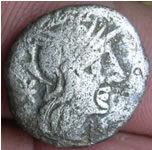  |
||||||||||||||||||||||||
|
Roman Republican silver coin 126 BC - Oldest coin ever found here 3.50g, 17.12mm 'This one is a Roman
Republican denarius of tribune/moneyer N. Fabius Pictor, struck at
Rome in 126 B.C (RSC/Babelon - Fabia 11), . This is another really interesting piece, not unlike the odd Greek coin you occasionally turn up, because despite its worn state - showing it was in circulation for quite some time - it's really "too early" of a piece to be in Britain. Unless, somehow, this piece was carried ashore by one of the soldiers of Julius Caesar's ill-fated British expeditions - at which time it would have been nearly 75 years old - it would have had to be bartered for tin or other trade-goods in the pre-Roman era or been part of some hoard or treasure which had been accumulated on the mainland and later transported to Britannia. It would have been very unlikely to be a circulating coin at the time of Claudius' successful invasion - at which time it would have been nearly 175 years old. So, you're left with it either travelling to Britannia by means unknown c. 100-60 B.C., or possibly having been held as an old and curious good luck piece or similar item by a much later' Roman Mark |
||||||||||||||||||||||||
|
Circa 11000 BC Middle Stone Age (Mesolithic) flint axe head - one for the museum to evaluate |
||||||||||||||||||||||||
|
Stunning
1554 Mary hammered silver groat (4 pence) |
||||||||||||||||||||||||
|
Dubnovellaunus Late 1st BC to Early 1stC AD Full Celtic gold stater 5.44g,17.57mm CCI 07.1130. |
||||||||||||||||||||||||
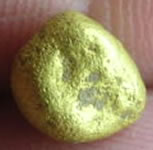 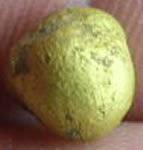 |
||||||||||||||||||||||||
|
Possible Celtic gold
nugget 2.17g,and is approx 6.73mm dia |
||||||||||||||||||||||||
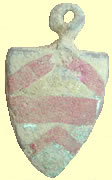 |
||||||||||||||||||||||||
|
Robert FitzWalter - enameled 13thC heraldic shield pendant Or a fess between two chevrons gules Robert le FizWater
Because of the interdict, the churches closed and their bells fell silent. With the church doors locked, services could not take place. The dead had to be buried in fields instead of in holy ground. People could not marry in church and baptisms had to be carried out in church porches. King John's excommunication also let off the barons from their oath of loyalty to him. Because they might rebel against him at any time, King John acted quickly against anyone who looked as though they might be disloyal. We know from the Medieval Chronicles that Robert FitzWalter, the 3rd Lord of Dunmow Castle, was accused of plotting to kill King John during a rebellion in 1212. The rebellion was quickly quashed. FitzWalter was outlawed and fled to France. Eventually in 1213, the Pope told King Philip of France that he could invade England and King John finally agreed to the Pope's terms including his choice of Archbishop. Robert FitzWalter returned home and, with the other Barons, he made peace with King John. This did not last long, however. It was found that FitzWalter was still plotting against the King and urging for the government to be reformed. Because of this, his home in London, the Castle of Baynard, was almost entirely destroyed Taxes, during King John's reign, were very high and became ever higher. In 1214, King John left England to fight a war in France. To make sure the army had enough supplies, the king's Regent of the time, Peter de Roches, raised a very big tax on the barons. The war was lost and, as in the story, on the Kings' return, Robert FitzWalter called a meeting at Bury St Edmunds Abbey where it was agreed that the King must agree to the laws and freedoms granted to the barons in the charter of Henry 1st, or they would declare war on him. Robert FitzWalter led the Baron's army under the title "Marshal of the Army of God and the Holy Church." In the end, the King was forced to sign the Magna Carta at Runnymede on 15th June 1215. Several copies of the Magna Carta documents still exist. Magna Carta means 'great charter'. To abide by Magna Carta, the King had to agree to certain laws and accept that his will was not above the law. It was not the first written document that put limits on the power of a king, but it was the first that was backed up by a council (of 25 barons) to try and make sure the king obeyed. It included a paragraph that said 'no free man shall be seized, imprisoned, disposed, outlawed, exiled or ruined in any way ? 'except by the lawful judgment of his peers?' John did not sign the document willingly and never intended to keep to it. In September 1215, just a few months after signing the charter, King John sent a message to the Pope asking him to annul the charter. The Pope agreed and excommunicated the barons that had signed it. As the fighting started again, FitzWalter slipped off to France and offered Prince Louis the English throne. Both Scottish and French armies invaded England. After fighting off the Scottish forces, King John's army changed direction to East Anglia, intending to quash the baron's rebellion. As his troops crossed the river Ouse on 11th October, they were caught by the rising tide and the crown Jewels sank into the Wash. Just a few days later, on 19th October, King John died at Newark. At the time of his death, the French flag flew over East Anglia. However, a French King did not rule England as no bishop would crown Prince Louis and many of the barons, who had rebelled against King John, now gave their support to his nine-year-old son Henry.
At the start of his reign, while he was away from England, he left Geoffrey FitzPeter in control as 'Regent'. He was a harsh man and did not worry about demanding heavy taxes and gave the local sheriffs a free hand to collect these by any means. He became very unpopular. Like most Kings of the time John was ruthless. It was also claimed that King John killed his nephew, Arthur, in 1206, to make sure of the future of the throne. However, history may not have been very fair to King John. At this time the historians, or chroniclers, were mainly monks. These monks would have been in sympathy with the parties that King John was arguing with - that is the church and the rich estate owners (barons). King John's reign was far from all bad for the country. Many towns such as Cambridge, Ipswich, King's Lynn and Norwich grew rich as they were given 'charters' and encouraged to govern themselves. The towns benefited from changes in the way taxes were paid and could get income from taxing market traders entering the town. R. Turner 1994 argued that John "...had intelligence, administrative ability and he was good at planning military campaigns. However, too many personality flaws held him back". Unfortunately for King John, no king of the time could have run the country successfully without the support of the powerful Barons and Noblemen. What of Matilda's supposed murder and her links with Robin Hood?
Matilda, his daughter, may indeed have been beautiful but very little is known of her life and death. After the rebellion of 1212, when FitzWalter and his family fled to France, it seems that he made his actions seem good, by saying the king was after his daughter and was plotting to kill his son-in-law. King John was not a pleasant man, but many historians do not believe FitzWalter's story. Robert FitzWalter had a shady past. He had surrendered Vaudreuil in France to the French king in 1203 under suspicious circumstances. So, whether what he did was because of King John's interest in his daughter or came from a wish for more power is difficult to say. The character of Maid Marion, like Friar Tuck, is not in the early ballads of Robin Hood. The character of Maid Marion probably came from an early French Pastoral romance ??he shepherd and shepherdess Robin and Marion'. Parts of this story and the Robin Hood stories probably merged and Maid Marion became Robin Hood's true love in the later versions of the legend. It is in Anthony Munday's Elizabethan "Huntingdon" plays; written in the 17th century that Marian becomes an alias employed by Matilda FitzWalter. A popular romance at the time was the legend of King John pursuing Matilda, daughter of Robert FitzWalter. Robin Hood or Robin of Loxley, if such a person existed, was not a well-known Nobleman but most likely a wronged landowner, fighting to regain his family seat. Dunmow Priory in Essex is said to be the resting-place of Robin Hood's Maid Marian. All that remains of Dunmow Priory is the present church of Dunmow; the south aisle of what was once a much larger building. However the story lives on, along with the many other tales of Robin Hood; and King John's jewels and royal regalia remain a treasure trove still to be found. |
||||||||||||||||||||||||
|
C10thC Saxon bronze key 10.41g, 40.88mm Lx19.58mm W x 6.30mm T |
||||||||||||||||||||||||
|
Find of the year Season 2006 - 2007 |
||||||||||||||||||||||||
| 22nd April 2007 NH Dave's Medieval Iconic gold ring wins find of the year 2006/2007 | ||||||||||||||||||||||||
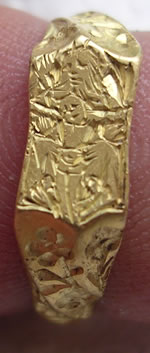 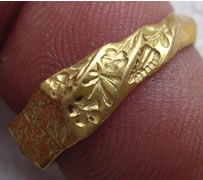 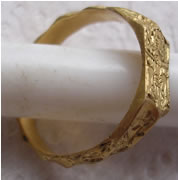 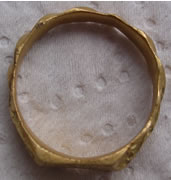 |
||||||||||||||||||||||||
|
Medieval Iconic
gold ring - declared treasure and currently awaiting purchase by Colchester
musuem |
||||||||||||||||||||||||
|
107/8 BC Roman Imperial silver 18.10mm, 3.83g |
||||||||||||||||||||||||
|
The second earliest
coin ever found here |
||||||||||||||||||||||||
|
|
||||||||||||||||||||||||
|
Medieval Madonna
and child hat badge 6.60g,19.92mm -declared treasure and currently awaiting
purchase by Colchester musuem |
||||||||||||||||||||||||
|
|
||||||||||||||||||||||||
|
1689 William
and Mary milled silver maundy 3 pence -
so rare to find this period and in this condition |
||||||||||||||||||||||||
|
1561-1582 2nd Issue, long cross mint mark - Elizabeth 1st hammered gold 1/4 Angel 1.16g,15.81mm North 1993 Obv ELIZABETH D G ANG FRANCIE Rev ET HIBERNIE REGINA FIDE |
||||||||||||||||||||||||
|
Medieval gold ring 1.18g - 24.26mm dia, 2.65 mm D x 0.73mm thick |
||||||||||||||||||||||||
|
'Found more on De Clare-- seems there was a Gilbert "The Red" (red haired) de Clare & son of Richard-- was one of the Earls of Gloucstershire (7th , I think) and had a whole bunch of other lands in 20 counties in Eng and Ireland. Joined the Montfort rebellion against the king. Married a jaon (Johanna) daughter of Edward II Longshanks , she was born in Acre - the site in the holy land where the Crusaders / Templar's lost it all . He was born in 1243'. |
||||||||||||||||||||||||
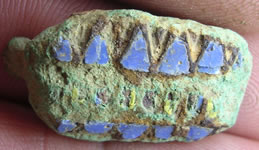 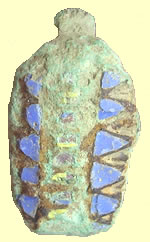 |
||||||||||||||||||||||||
|
2nd C Roman blue
and yellow enameled Plate brooch - 7.56g,28.1mm L x 15.46mm W |
||||||||||||||||||||||||
|
2nd C Roman bronze statue in uniform (possibly military) with toga over arm - some red enameling remaining 28.87g, 52.25mm H |
||||||||||||||||||||||||
|
Charles 1st 30
shillings 14.95g, 35.63mm Obv - CAROLUS D.G MAGN BRITAN FRAN ET HIB REX B - Charles by the grace of God King of Britain France and Ireland B(riot) Rev QUAE DEUS CONIVNXIT NEMO SEPARET - What God hath joined together let no man put asunder |
||||||||||||||||||||||||
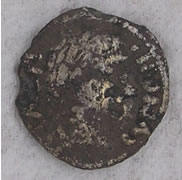 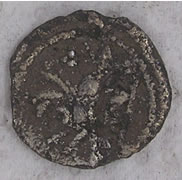 |
||||||||||||||||||||||||
|
'further
to yesterday's email, yes, this is a rare silver unit of Cunobelin.
The type is in recent volumes of 'Coins of England' (no. 310) but isn't
in VA or the BMC catalogue. I've attached an image of the best of the
six we already have here for you to compare. I'll
record it as CCI 06.0523. Congratulations on a rare find!'
|
||||||||||||||||||||||||
|
Viling period - Thor's hammer pendant - silvered base metal 2.45g - 22.59mm L
|
||||||||||||||||||||||||
|
Saxon C600-775 AD Silver Sceat 1.23g,11.15mm EMC 2006.0342 |
||||||||||||||||||||||||
|
Cal
Jeff's Willy wins find of the year 2005/6 !! |
||||||||||||||||||||||||
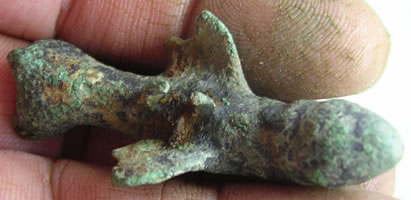 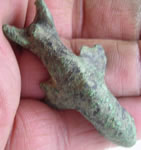 |
||||||||||||||||||||||||
|
Roman bronze
winged Phallus pendant 27.87 - 49.02mm L found by Cal Jeff |
||||||||||||||||||||||||
 |
||||||||||||||||||||||||
|
9thC Anglo
Saxon decorated silver strap end 5.82g, 44.44mm L x 11.91mm W
found by Cal Shawn |
||||||||||||||||||||||||
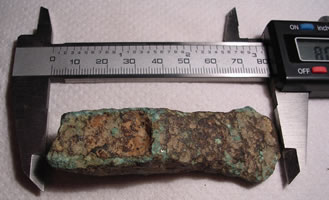 |
||||||||||||||||||||||||
|
1250 BC
Bronze age socketed axe found by NH Scott. 77.38mm L x 29.45 W |
||||||||||||||||||||||||
 |
||||||||||||||||||||||||
 |
||||||||||||||||||||||||
|
1400BC
Bronze age spear 11.61g, 55.75mm L 10.43mm W found by Vermont Harold |
||||||||||||||||||||||||
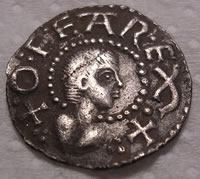 |
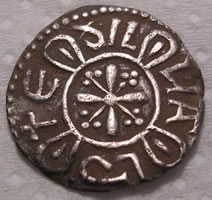 |
|||||||||||||||||||||||
|
EMC 2005.0229 found by NY Ken King Offa - 780 - 792 King of Mercia hammered silver 1.27g, 16.67mm OFFA REX (‘King Offa’) and, on the reverse side, Eð / IL / VA / Ld (‘Ethilwald’ - the moneyer who authorised the minting of the coin). |
||||||||||||||||||||||||
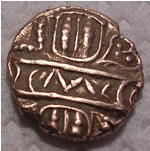 |
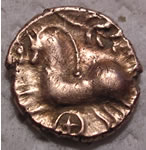 |
|||||||||||||||||||||||
|
CCI 05.0688 1.38g, 10.89 mm found by Wis Paul 'another cracking little coin. It is the biga type as you say, still quite rare: we have just over 20 of the quarter recorded. I had hoped to have a look at the dies in comparison to the rest of the coins in Oxford this morning, but ran out of time and I'm now back in Guernsey again. That'll have to wait a while, but in the meantime it looks as though it's one of the later strikings of this type, because of the simplified CAMVL inscription on the obverse. The earliest examples have each letter very clearly defined, but they soon merge into what looks almost like a zigzag on some coins. Saying it's a 'late striking' is all relative of course: it's possible that the biga type was struck over a very short period, perhaps even just months and certainly unlikely to be more than say five years or so, sometime around 8 - 13 AD I would estimate. It'll be CCI 05.0688 |
||||||||||||||||||||||||
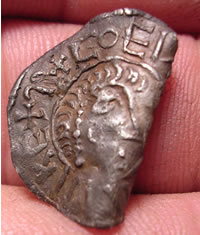 |
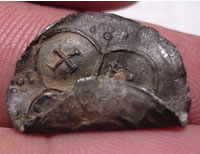 |
|||||||||||||||||||||||
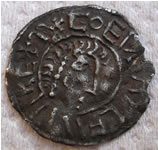 |
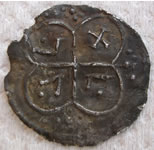 |
|||||||||||||||||||||||
|
Coenwulf, king of Mercia (796-821) 1.31g, 19.78mm found by Wis Paul EMC 20050226 'This is a good example of the earliest East Anglian coinage of Coenwulf (North 363). It is quite rare, as there are only two other examples of North 363 on EMC, from dies of different styles'. |
||||||||||||||||||||||||
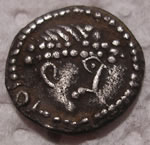 |
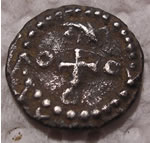 |
|||||||||||||||||||||||
|
Saxon Primary silver Sceattas c 680 - 710 AD, 1.16g - 11.85 mm found by Ohio Tony EMC 2005.0208 |
||||||||||||||||||||||||
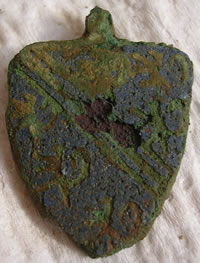 |
Humphrey
De Bohun
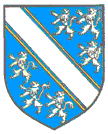 |
|||||||||||||||||||||||
|
Medieval
harness pendant found by Ohio Bud |
||||||||||||||||||||||||
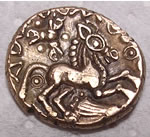 |
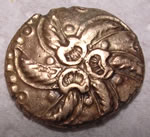 |
|||||||||||||||||||||||
|
CCI 05.0655 - 5.58g - 18.38 mm 45 BC Addedomaros Celtic gold full stater found by Florida Don |
||||||||||||||||||||||||
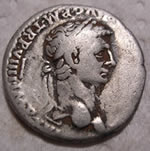 |
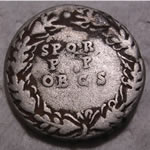 |
|||||||||||||||||||||||
|
Claudius,
49-50 A.D. and is RIC I, 49 - frequency "R4"! found by Boston
Beau |
||||||||||||||||||||||||
|
Season 2004 - 2005 Won by Boston Bill's 4thC Roman gold ring |
||||||||||||||||||||||||
|
|
||||||||||||||||||||||||
 |
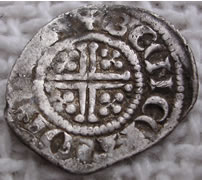 |
|||||||||||||||||||||||
|
King John
1205 AD hammered silver penny - - found by Boston John |
||||||||||||||||||||||||
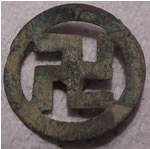 |
||||||||||||||||||||||||
|
WWII artifact
found by Boston Bud on the site of a crashed Dornier bomber. |
||||||||||||||||||||||||
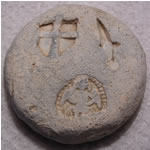 |
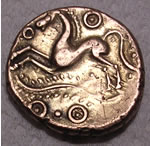 |
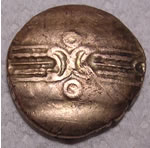 |
||||||||||||||||||||||
|
Mint condition
2" diameter - 1/4 pound - Plumbers mark in circle, sword and shield.
This is a rare one not in the reference books. Possibly pre - 1605 found
by Boston Bud |
Dubnovellaunus
Late 1st BC to Early 1stC AD Full Celtic gold stater found by Texas
Dave |
|||||||||||||||||||||||
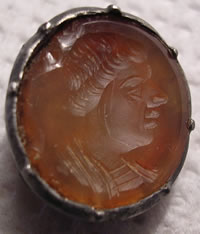 |
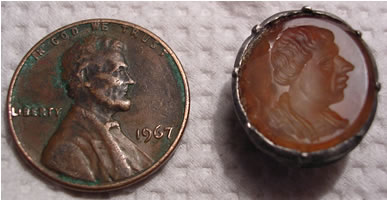 |
|||||||||||||||||||||||
|
What a find - etched onto an amber coloured stone and set in silver. The face is different depending on how the light hits it. It is probably a husband and wife memento , what an amazing find. Dated 18thC by museum ,found by Boston Bud |
||||||||||||||||||||||||
 |
 |
|||||||||||||||||||||||
|
17thC gold
ring found by Canadian Marjoline |
||||||||||||||||||||||||
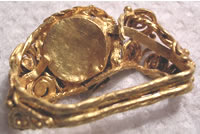 |
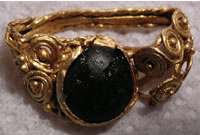 |
|||||||||||||||||||||||
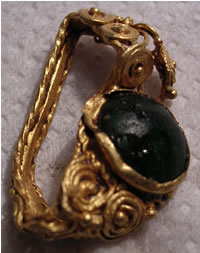 |
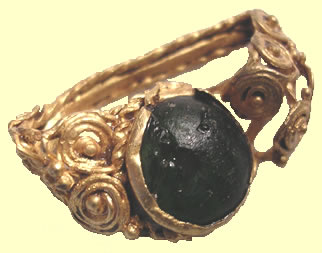 |
|||||||||||||||||||||||
|
4thC Roman
gold ring found by Mass Bill |
||||||||||||||||||||||||
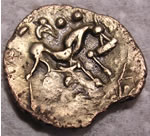 |
 (b) (b) |
|||||||||||||||||||||||
|
Clacton Type 1/4 Celtic gold Stater found by Manhattan Gary
'This is an example of the Clacton 1/4 stater - it's not listed in VA, but there's one in the British Museum catalogue, at BMC 192 (where it's incorrectly attributed to the Corieltauvi). These coins were virtually unknown until the 1980s, but we now have records of more than 50 of them, predominantly from Essex, and it seems certain to be the quarter stater type associated with the full Clacton stater. There is strong Gallo-Belgic influence, as you mention - the obverse seems to be copied from the 'three men in a boat' design found on the imported Gallo-Belgic quarter staters, while the reverse is indeed nearly identical to the Clacton stater type. Its date is probably c. 50 BC. This one will be in the Index as CCI 04.2136'. |
||||||||||||||||||||||||
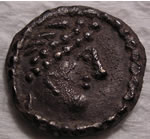 |
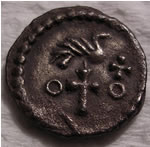 |
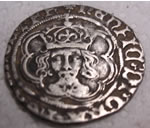 |
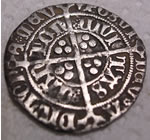 |
|||||||||||||||||||||
|
Saxon Primary
silver Sceattas c 680 - 710 AD(g) found by Mass Bill |
Mint condition
hammered silver half GroatHenry VII 1485 found by Wis Wayne |
|||||||||||||||||||||||
 |
||||||||||||||||||||||||
|
Beautiful
14thC Medieval enamelled pendant, my favourite find of the year so far(y)
found by Cal Charles |
||||||||||||||||||||||||
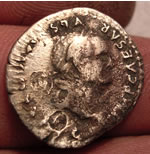 |
 |
|||||||||||||||||||||||
|
It's a denarius of the Emperor Vespasian (69-79 AD), minted in Rome AD 75. Obverse: Reverse: Thanks
to Jan de Veen of the UR forum for ID Found by Cal Charles |
||||||||||||||||||||||||
|
28th April 2004 - Mass Bruce's axes win this years find of the year by popular vote |
||||||||||||||||||||||||
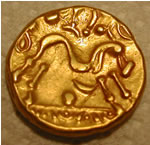 |
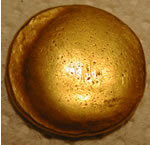 |
|
Celtic gold stater- probably
Galo Belgic type 50BC (c) found by Texas Gary |
|
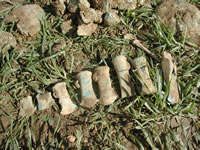 |
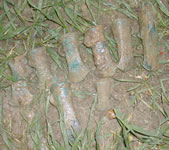 |
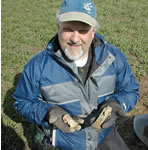 |
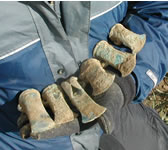 |
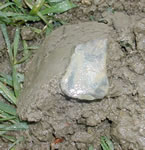 |
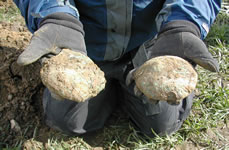 |
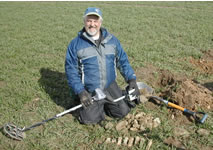 |
|
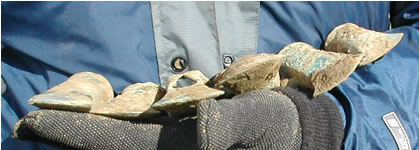 |
|||
 |
 |
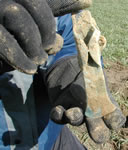 |
|
|
1500BC bronze age looped axe head hoard and ingots found by Mass Bruce
|
|
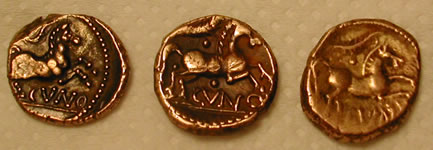 |
|
 |
|
|
Virginia
Brian's Celtic gold coin hoard. 3- Cunobelin Gold full staters 10 to
40 AD |
|
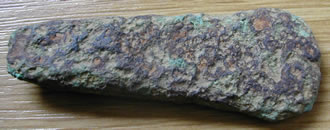 |
 |
| Initail indications from the photo suggest it is an early bronze age flat axe 2000BC. These are quite a rare find in Essex, so this one will be looked at by the British Museum for confirmation. They are abundant in Norfolk, with quite a few in Suffolk". Found by Vancouver Brent | |
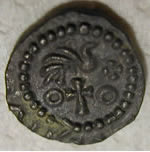 |
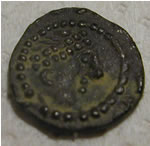 |
|
Saxon silver 670AD (uncleaned)
found by Vancouver Dave |
|
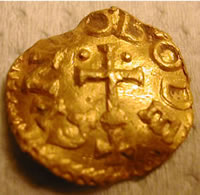 |
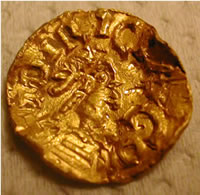 |
|
Saxon period gold coin 6th/8thC,Early Continental (Merovingian Francia) (584-750), Ruler: anon. (tremissis) (590-670) Type: Merovingian tremissis (500-675)found by Boston Bud
|
|
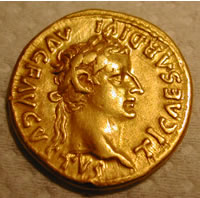 |
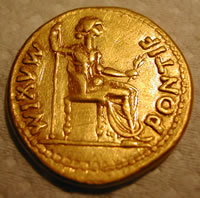 (c)
(c) |
|
Tiberious 14 to 37 AD gold
Aureus found by Michigan
Tracy |
|
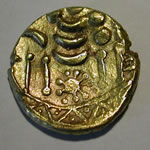 |
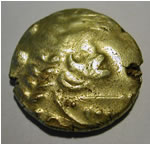 |
|
|
Another amazing Celtic
gold stater- Galo Belgic Clacton type 70BC and it is actually in the
coin book for once !! Found by Nevada Gary |
||
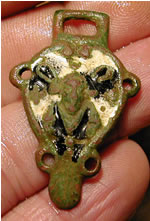 |
||
|
Medieval cloth fastener
found by Milwaukee Mike |
||
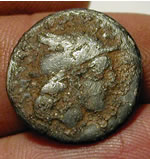 |
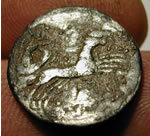 |
|
|
Roman Republican denarius, c.100 BC, what a fantastic find found by Nevada Gary obv. {RO]MA, head of Roma, r. |
||
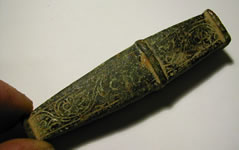 |
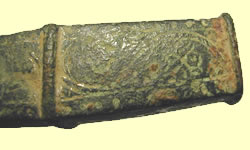 |
|
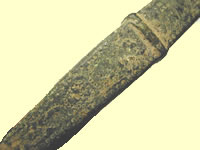 |
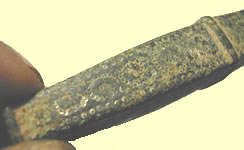 |
|
|
What a beautiful artifact,
a 15th C ornate dagger handle, traces of silver inlay remain.
Found by Milwaukee Mike |
||
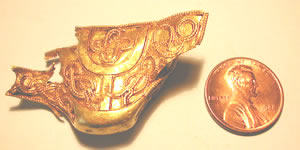 |
|
|
| What can you say about a find like this, just beautifully tooled solid gold and probably owned by a very important Saxon 7thC. Found by Ohio Bud | ||
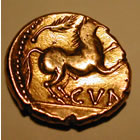 |
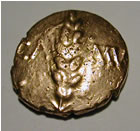 |
|
|
Cunobelin Gold full stater
10 to 40 AD found by Texas John |
||
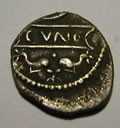 |
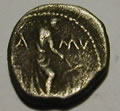 |
|
|
Cunobelin silver quarter
stater, this could be very rare as it is not in the coin books again
!! Found by Irish Niall |
||
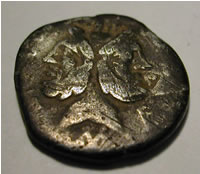 |
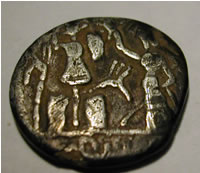 |
|
|
Arizona Bert's 118BC silver
Roman |
||
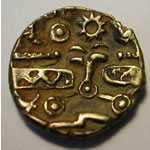 |
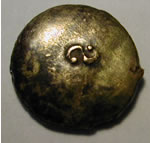 |
|
|
One of a kind Celtic gold 1/4 stater found by Alaskan George Latest views from the experts "it's an early (perhaps c. 50-40 BC) quarter stater, possibly
produced in Essex. This particular type is unpublished in any major catalogue, |
||
 |
 |
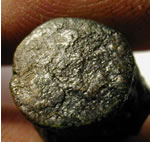 |
|
Medieval bronze wolfs head
found by Savannah George |
||
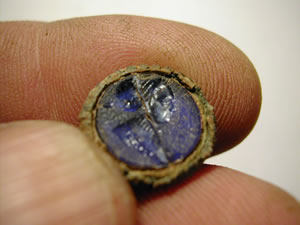 |
||
|
Californian Dan's Intaglio
- 17thC |
||
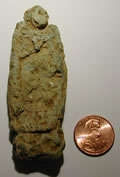 |
||
|
Probably Medieval in date
lead skeleton found by Georgia Mike. Could not be positively ID'd by
the museum |
||
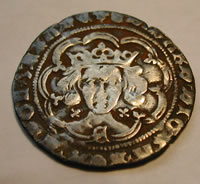 |
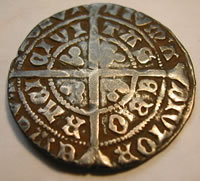 |
|
|
Edward IV Silver hammered
groat found by Canadian Don |
||
 |
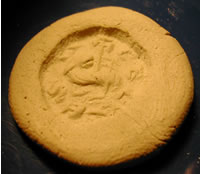 |
|
|
12thC seal matrix, lamb
with legs tucked underneath- pictures do not do this justice
found by Kentucky Joe |
||
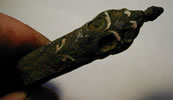 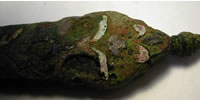 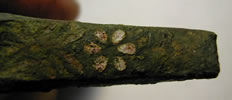 |
||
|
Exciting heavily decorated
and enameled bronze find, back from the museum and now dated as probably
Victorian but still a great find, found by Billericay Mark |
||
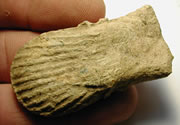 |
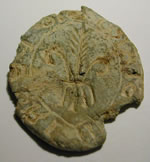 |
|
|
12th -13thC Pilgrims lead
ampoule,found by Billericay Mark |
14thC seal found by Essex
Dave |
|
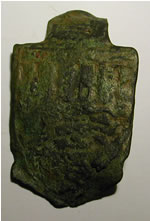 |
 |
|
|
Heraldic pendant with traces of red,blue and green enameling remaining, First Earl of Lancaster, Edmond " Crunchback" , son of King Henry III. Around the end of `1200's found by Georgian Mike |
Royal Air force tiny silver
insignia found by the Mrs |
|
 |
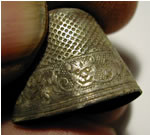 |
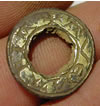 |
|
Really nice 18thC silver
decorated clog fastener found by NE Jerry |
Early decorated silver
thimble with lions head design |
Medieval ring 'avai maria'
found by Texas Jim |
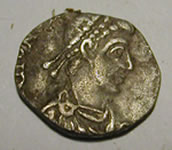 |
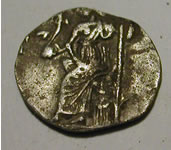 |
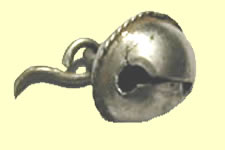 |
|
Silva siliqua of Constantine
III 5thC found by Texas Dave
|
Superb find, silver Medieval
decorated hawking bell and it still rings ! found
by Ohio Eric |
|
 |
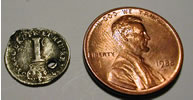 |
|
|
Really nice 1758 George
II silver one pence found by Ohio Eric |
||
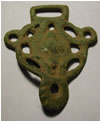 |
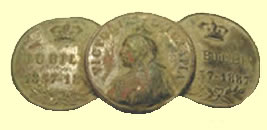 |
|
|
Medieval Dress fastener
found by Irish Naill |
Victoria 50th jubilee medal
1887 found by Ohio Bud |
|
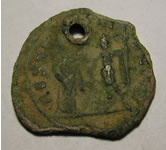 |
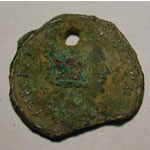 |
|
|
4thC Roman bronze used
by an 8thC Saxon as a pendant- found
by Connecticut Dave |
||
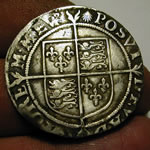 |
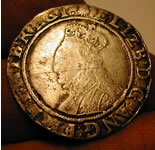 |
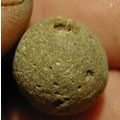 |
|
1500's Elizabeth 1st silver
hammered shilling found by Texas Kenny |
Another great eyeball find,
stone bead, this could be very old |
|
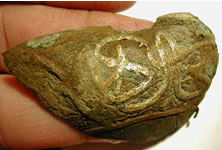 |
 |
||
|
Beautiful ornate, silver
inlay metal pot pieces found by Texas Kenny - Middle eastern |
|||
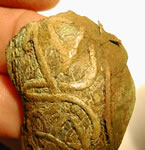 |
 |
||
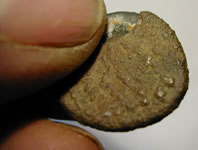 |
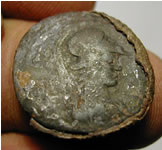 |
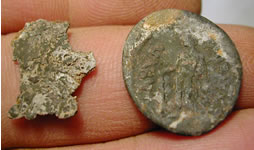 |
|
| From a duckling to a swan ! Crusty
Roman coin, pick it and heh presto ! Roman Republican denarius of Vibius,
42 BC found by Milwaukee Mike. obv. Helmeted bust of Minerva r., wearing
aegis. Border of dots. rev. C.VIBIVS VARVS, Herculus standing facing, holding club in r. hand and lion-skin overl. arm. Border of dots |
|||

